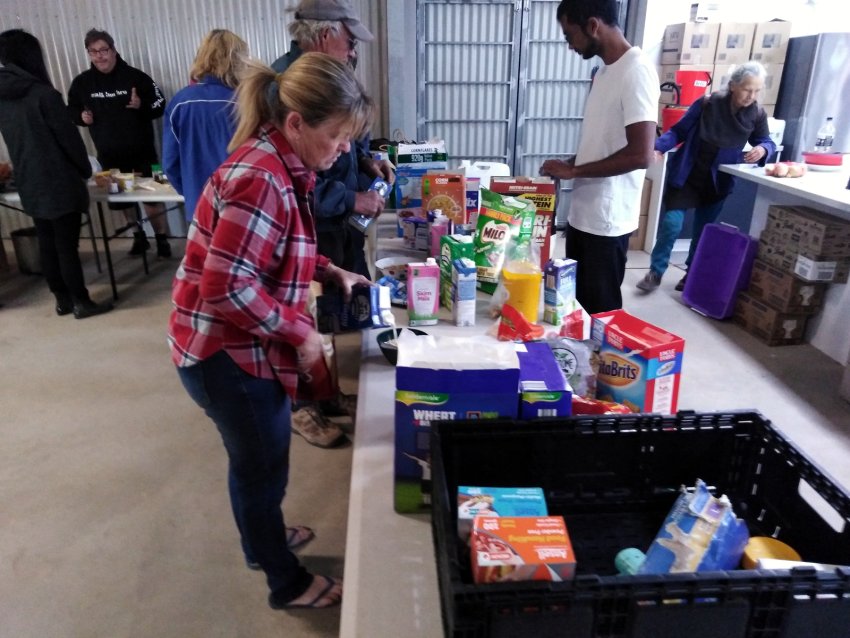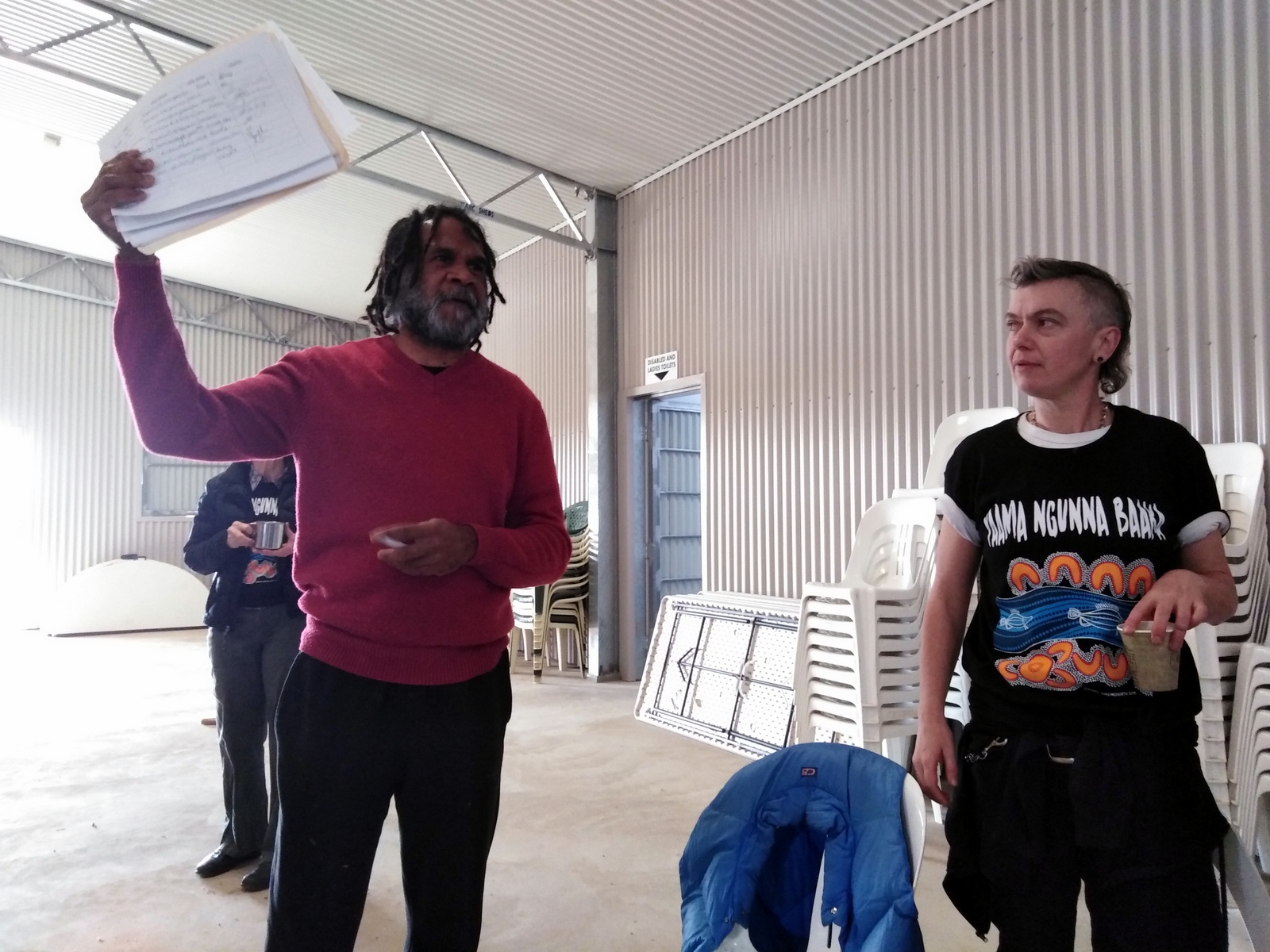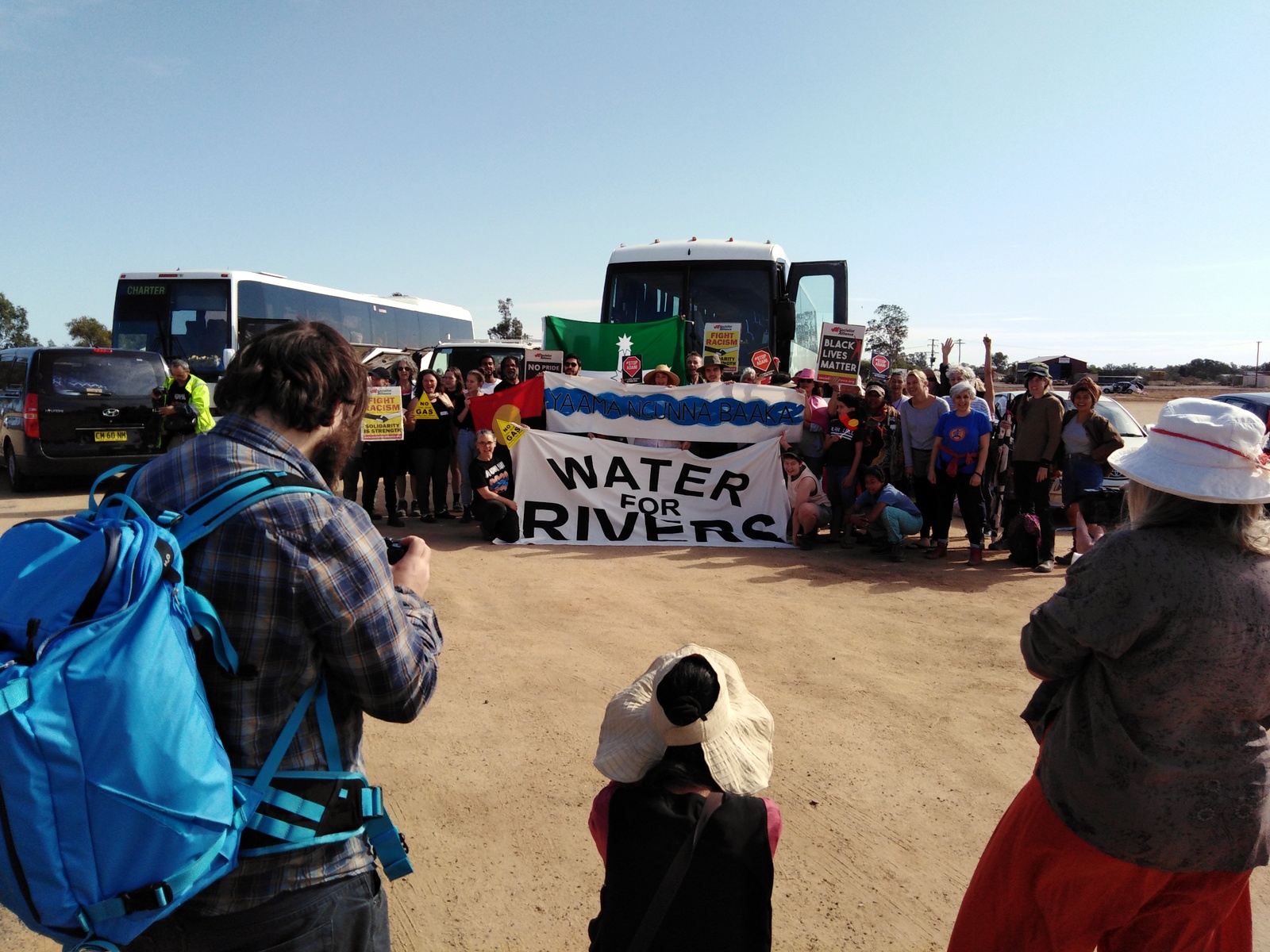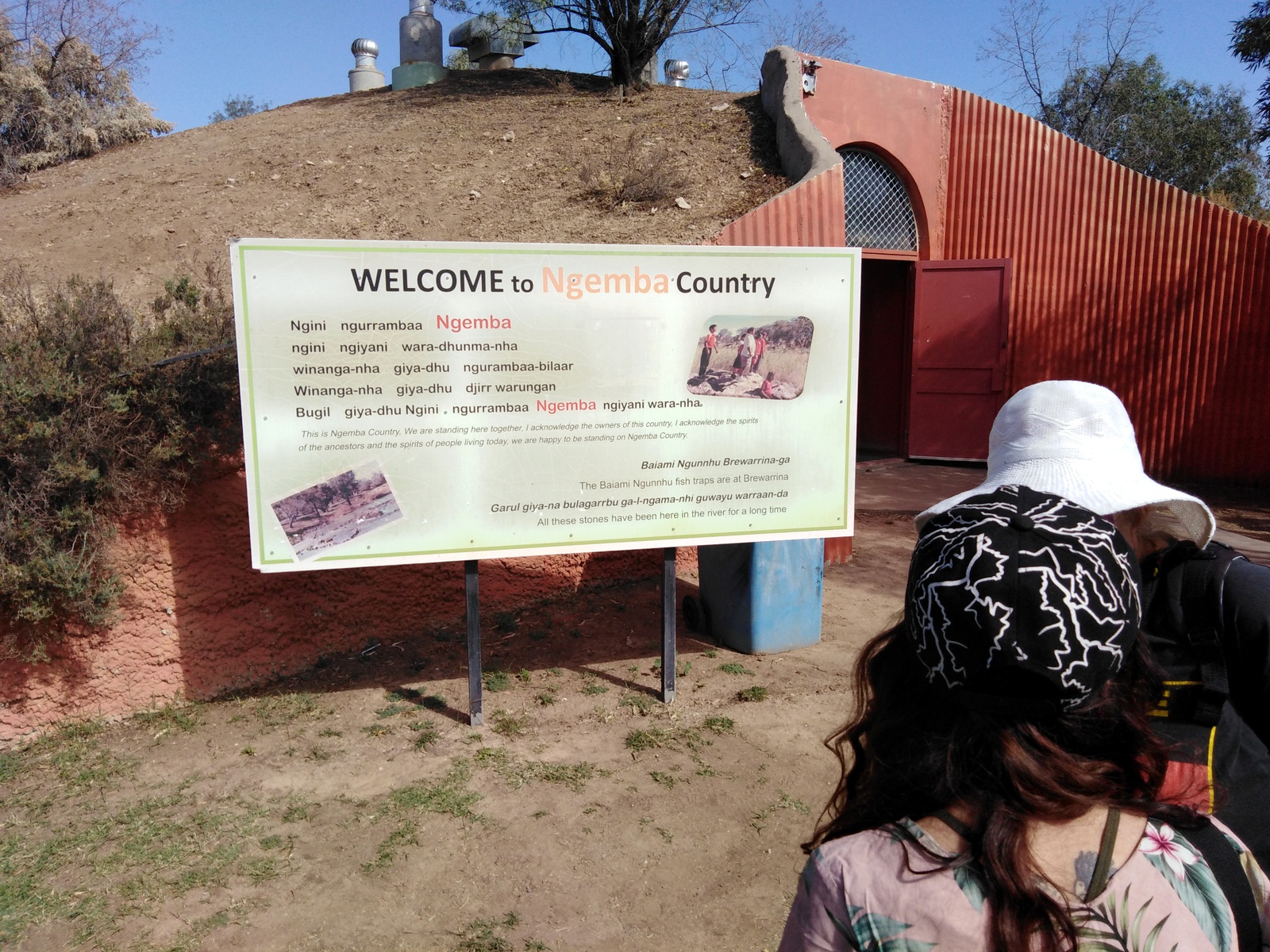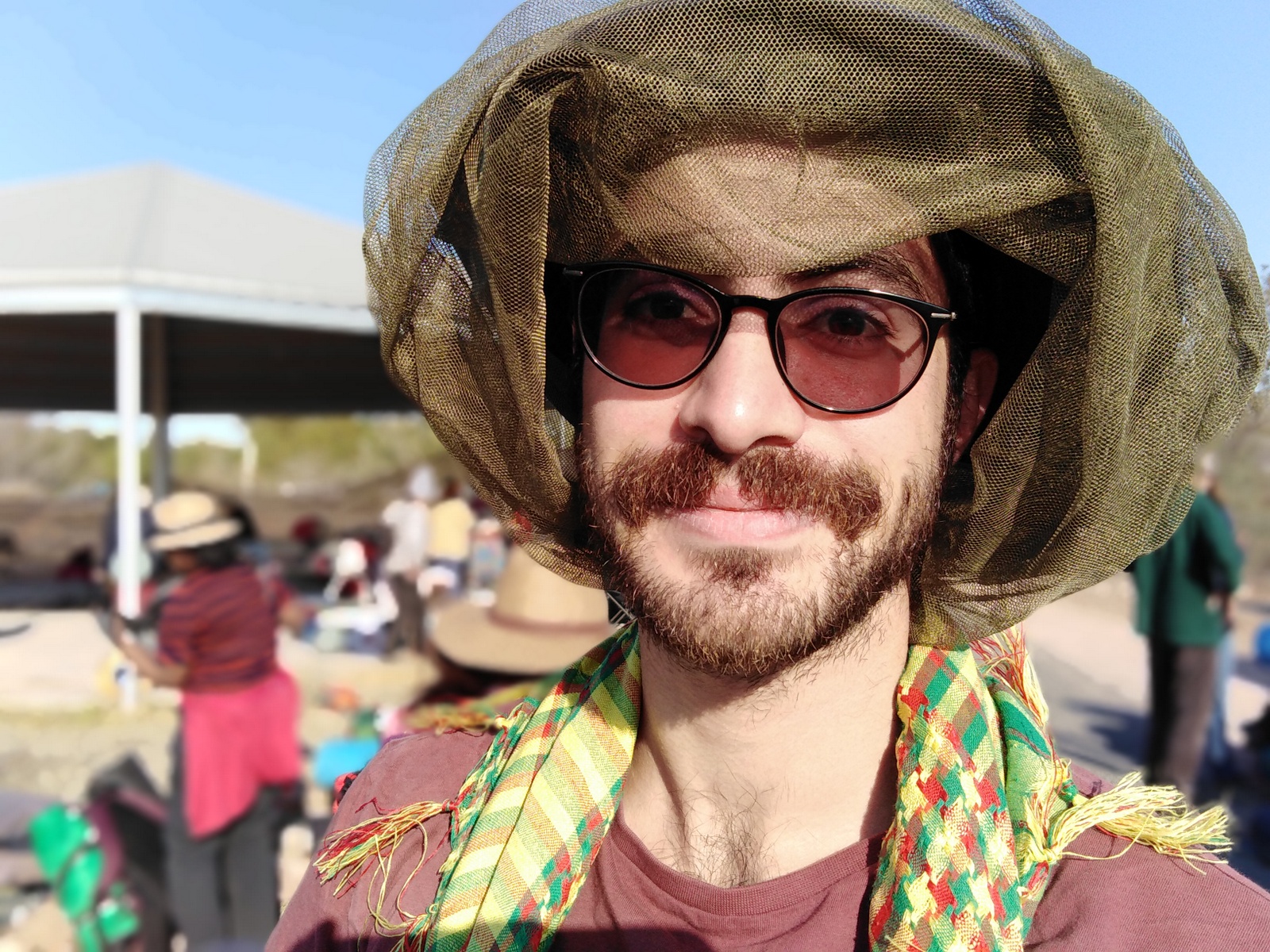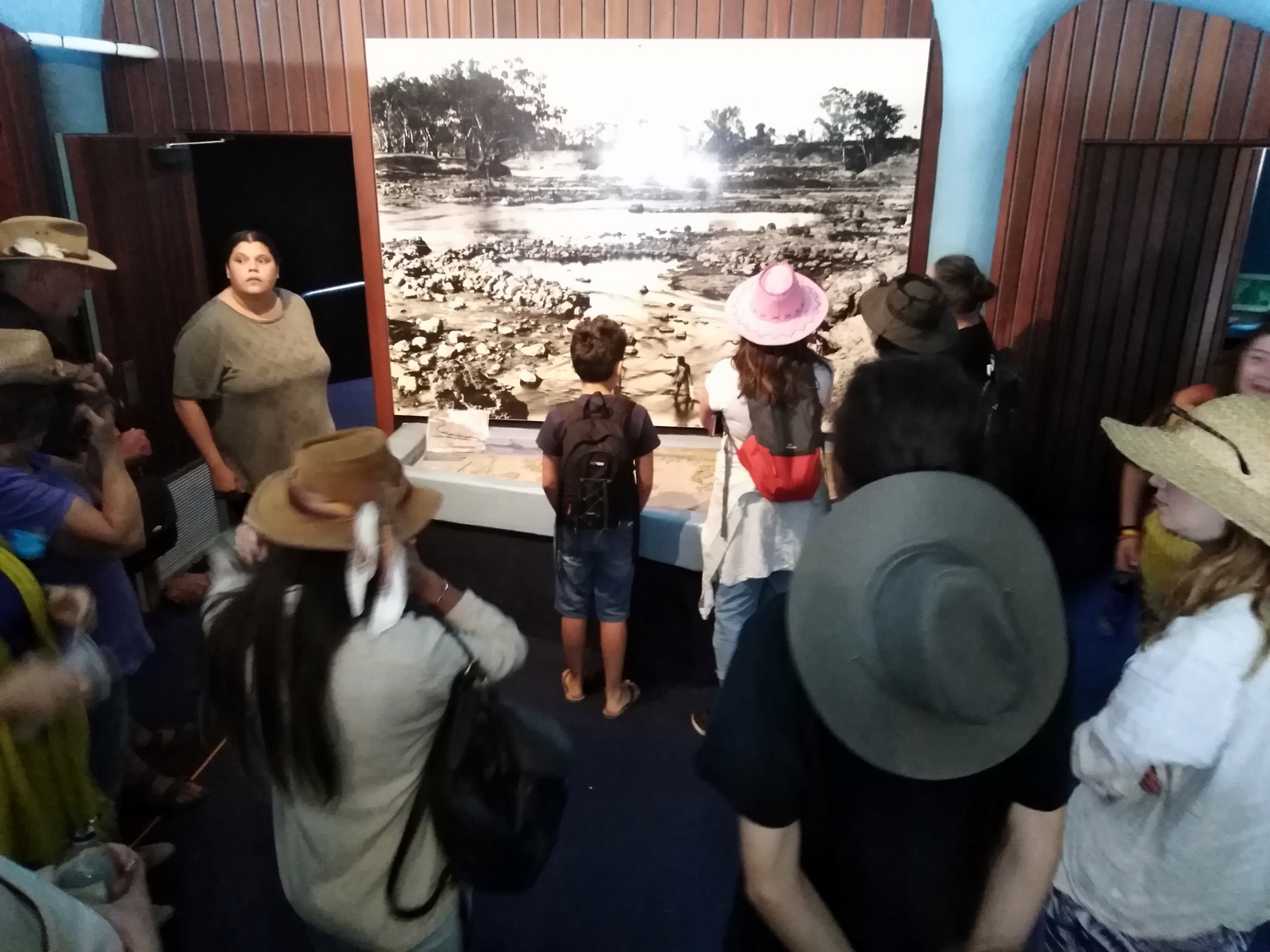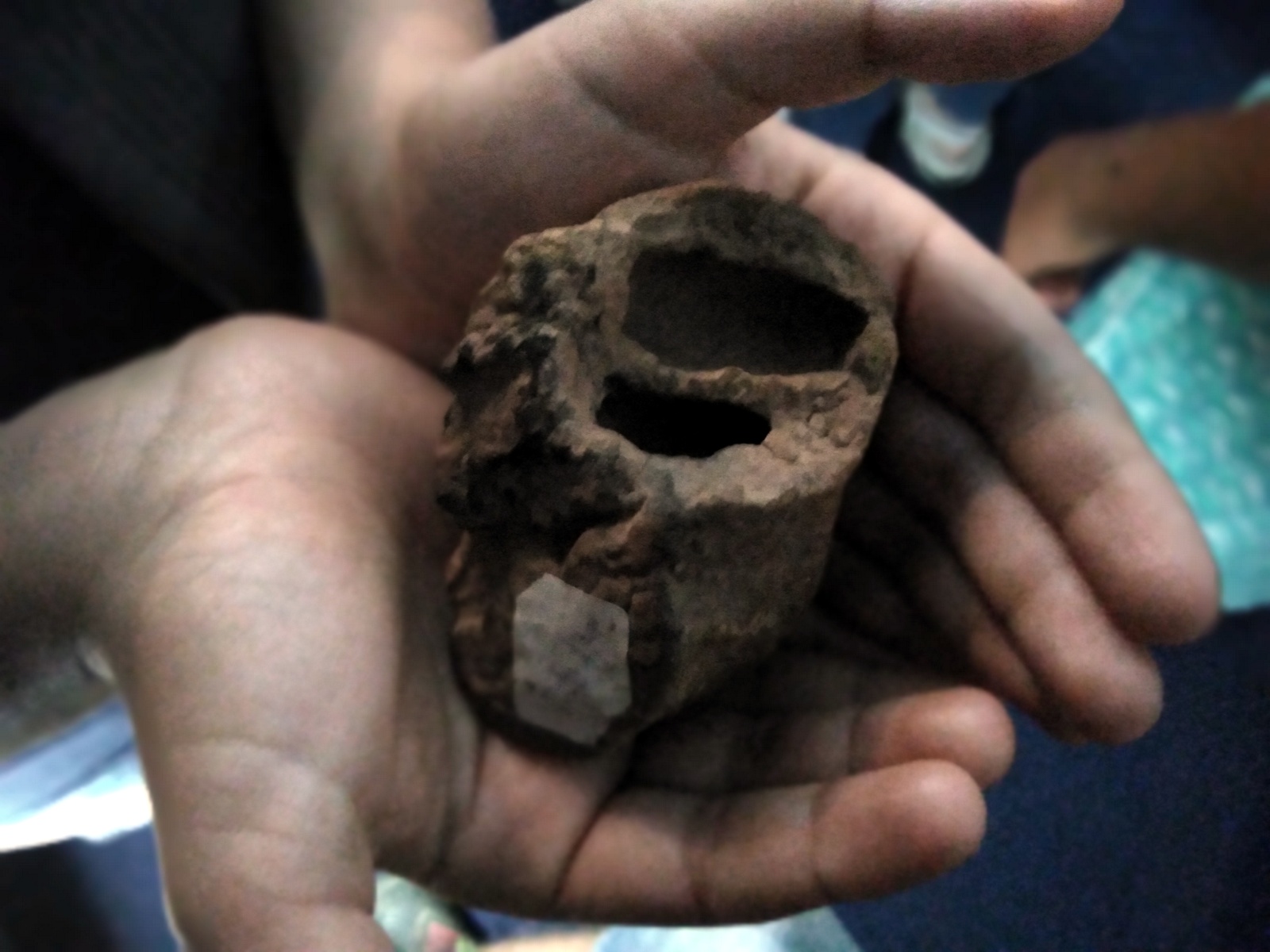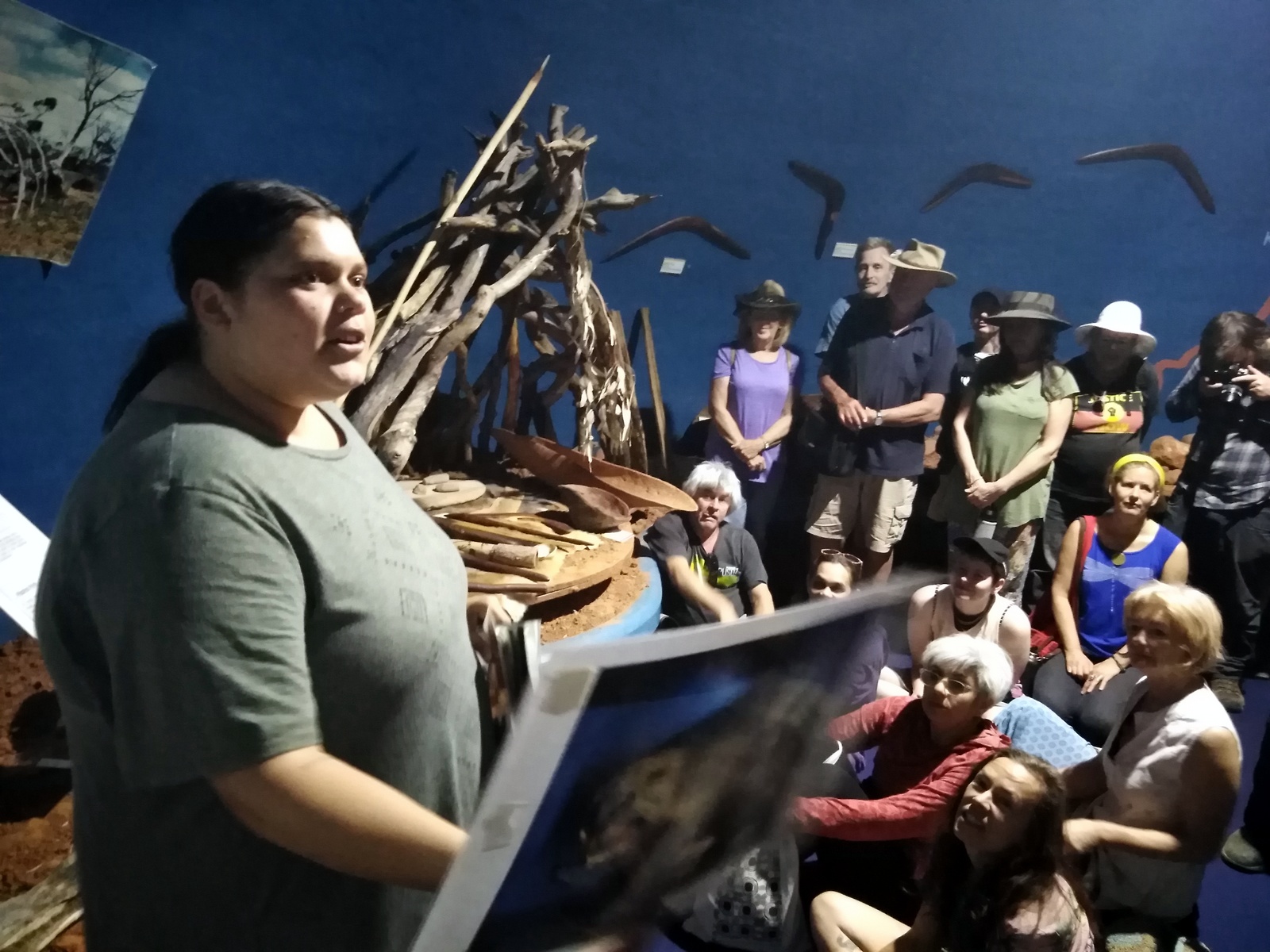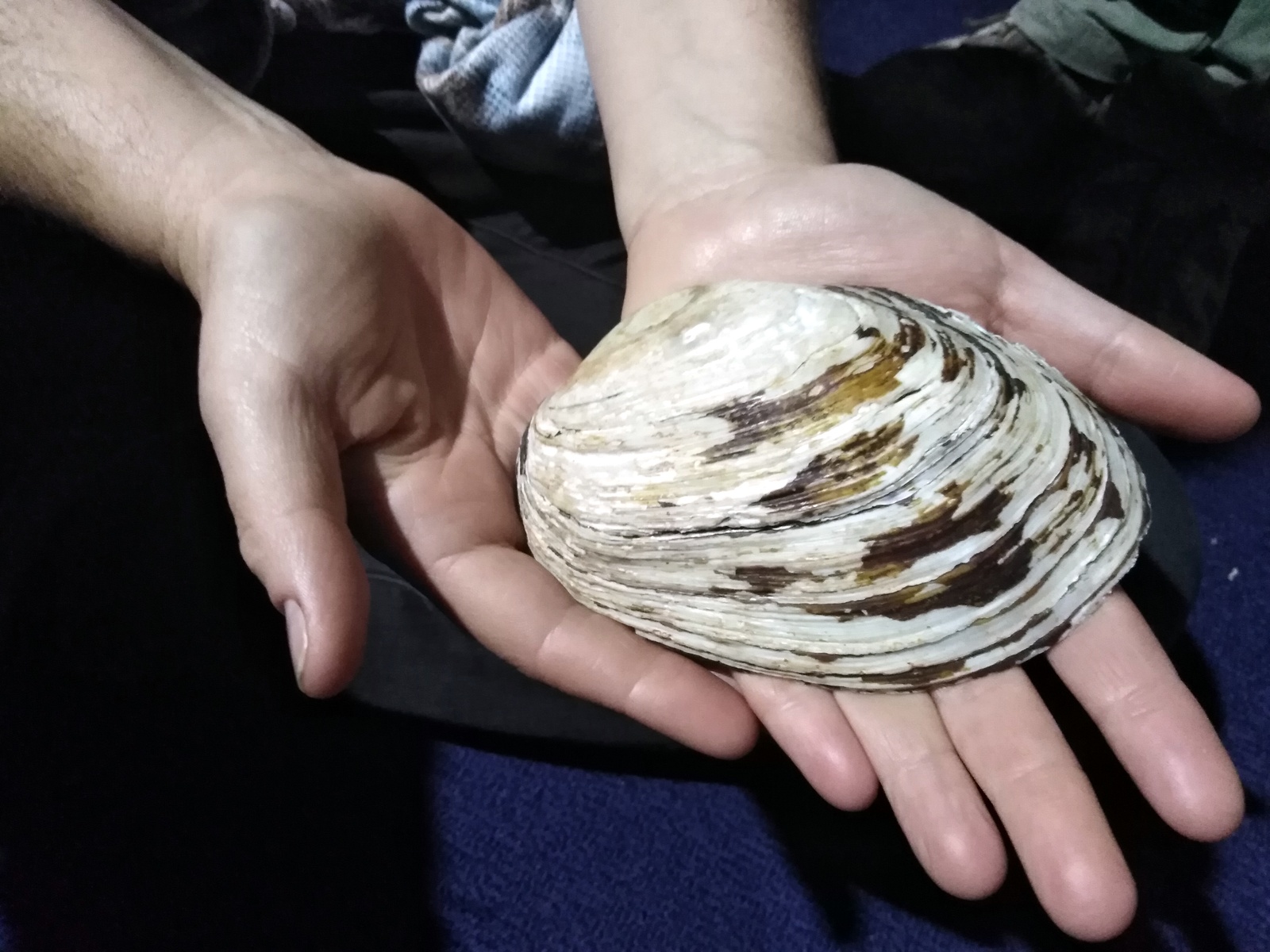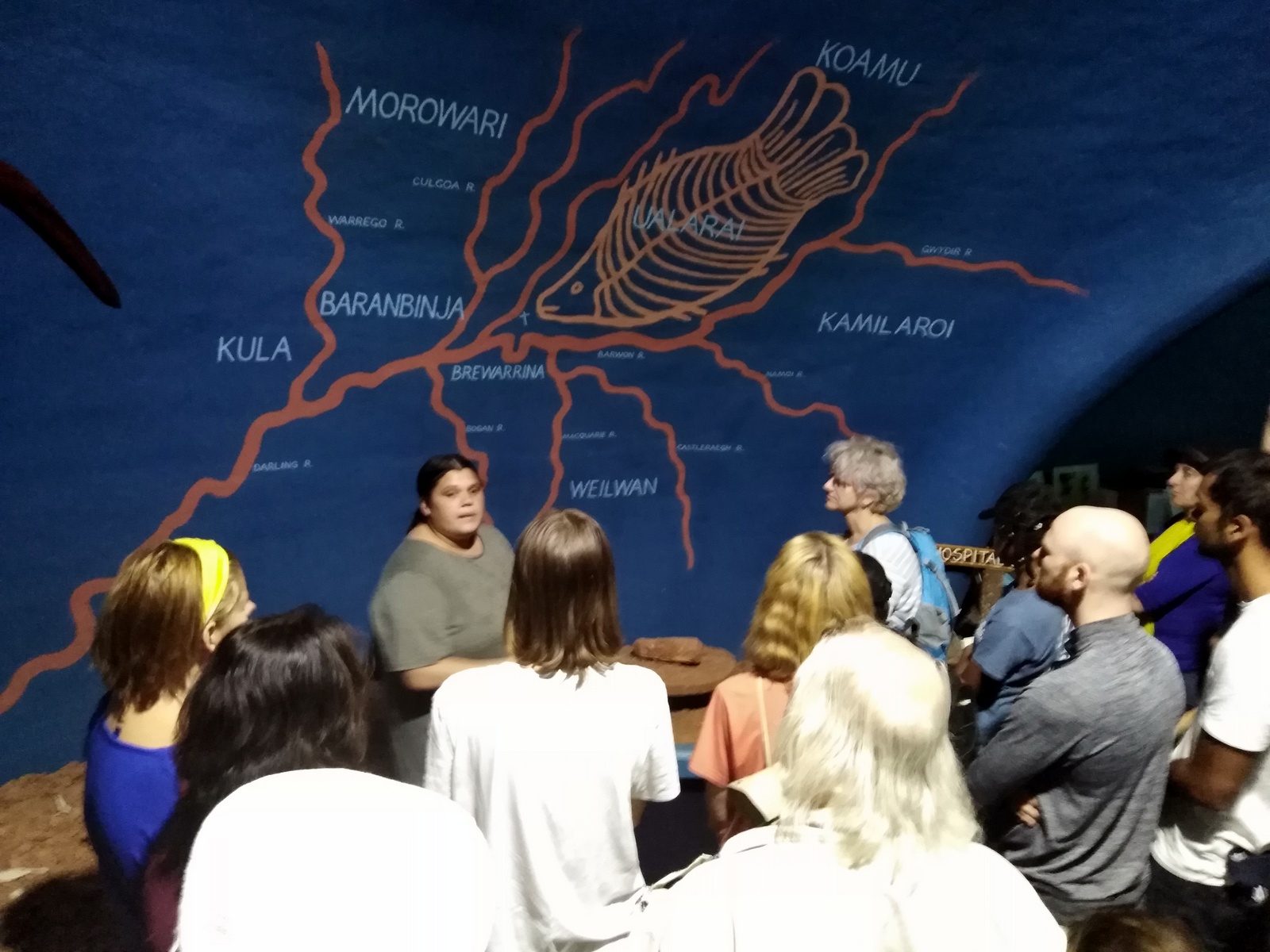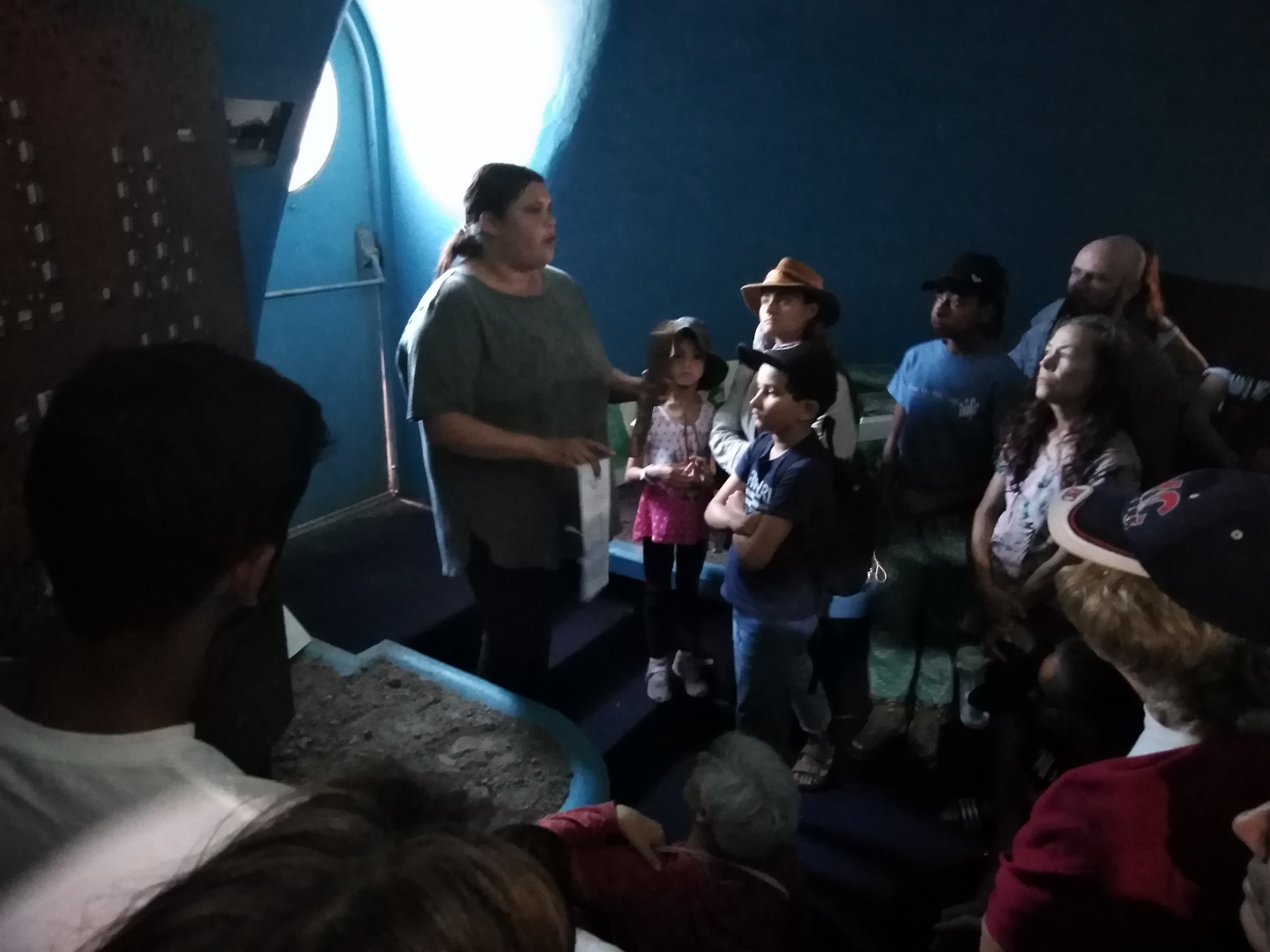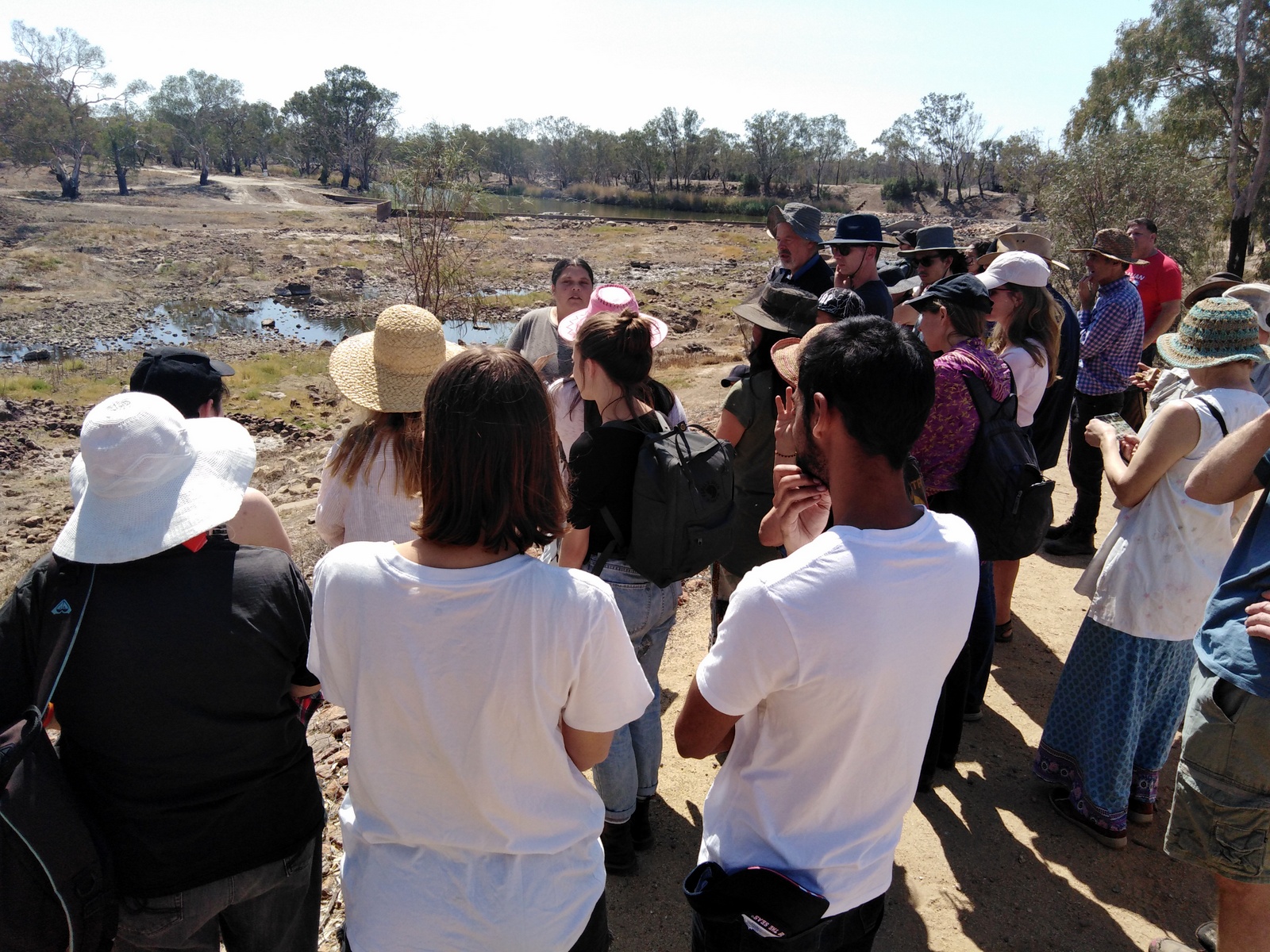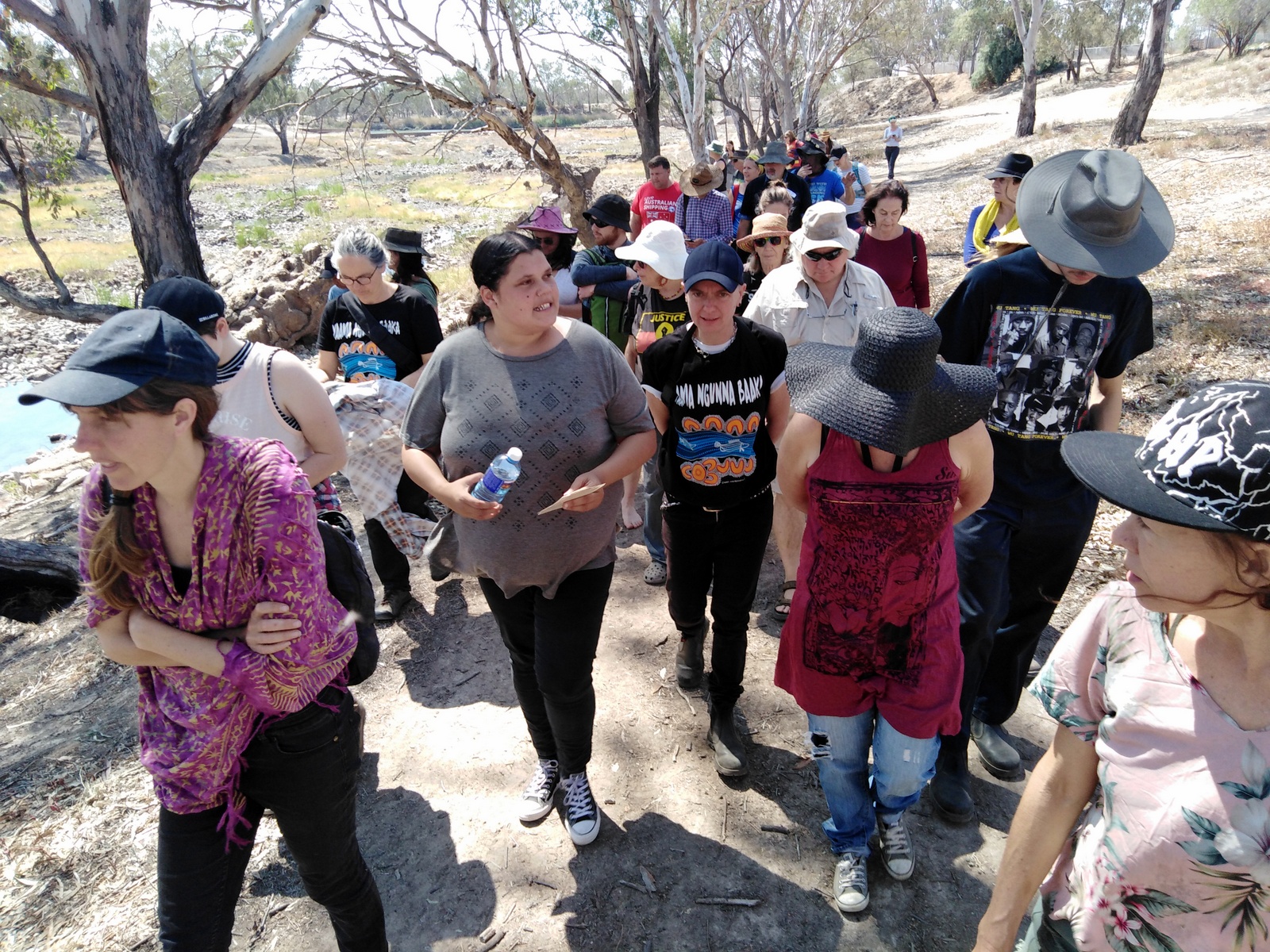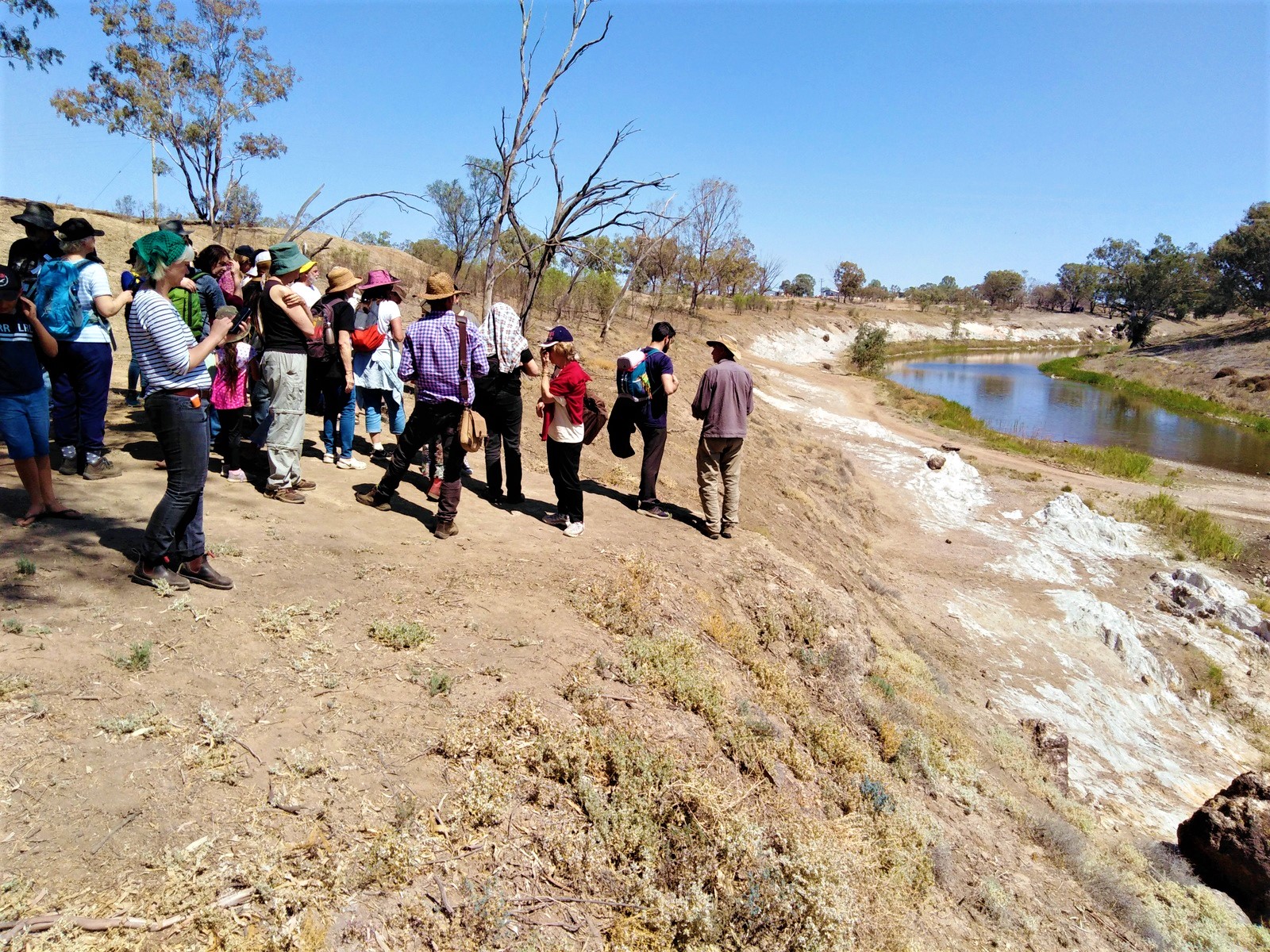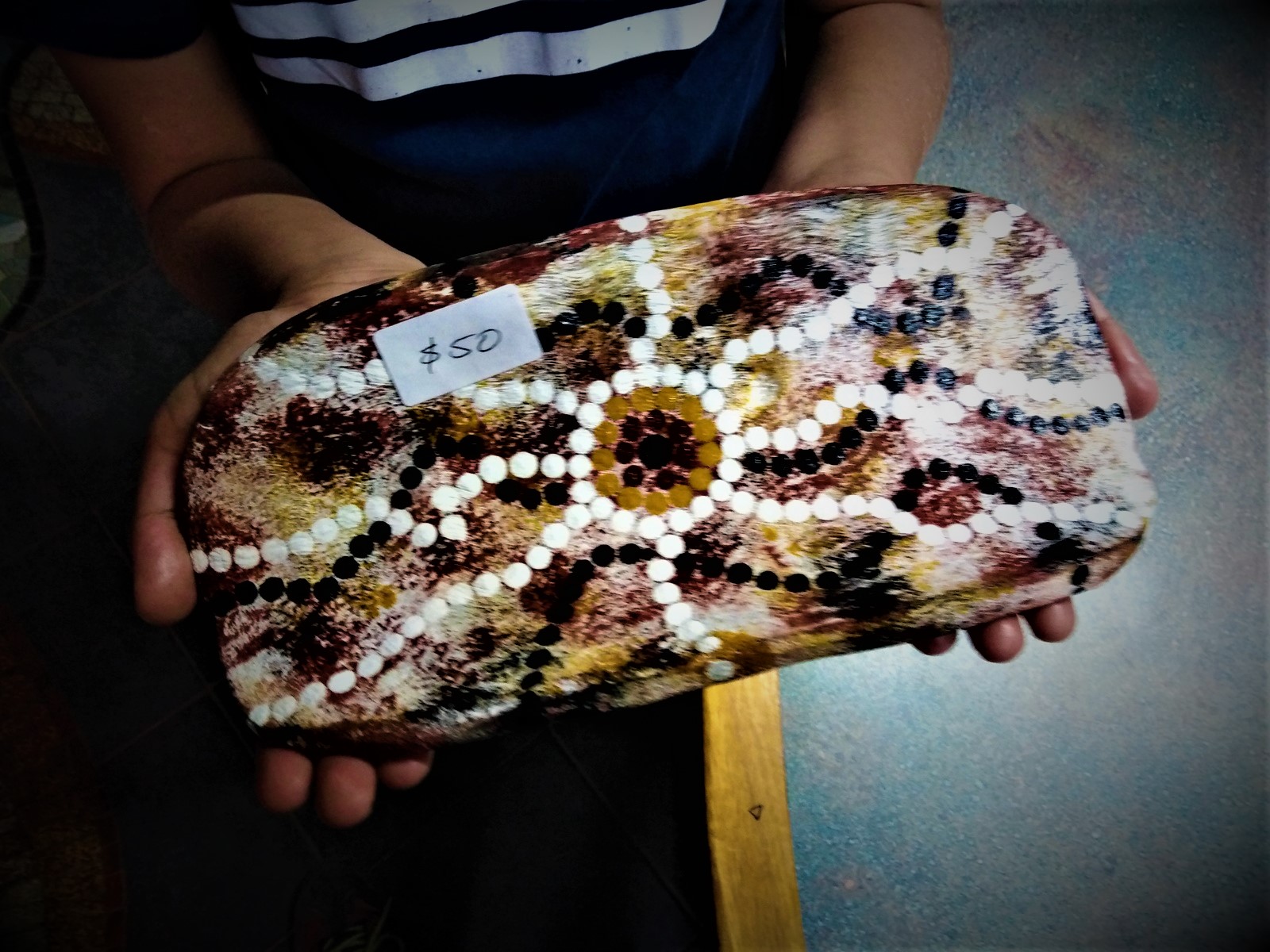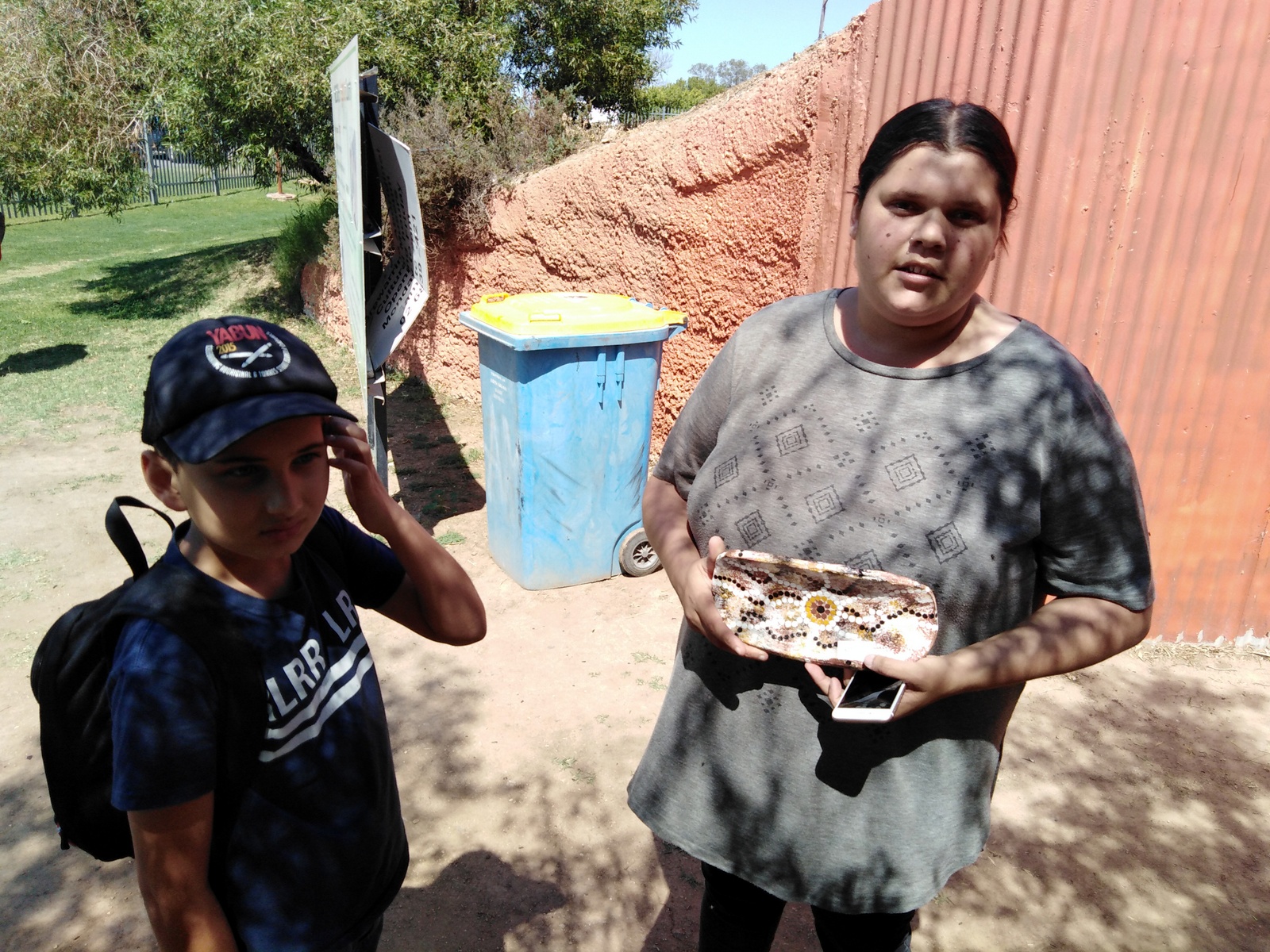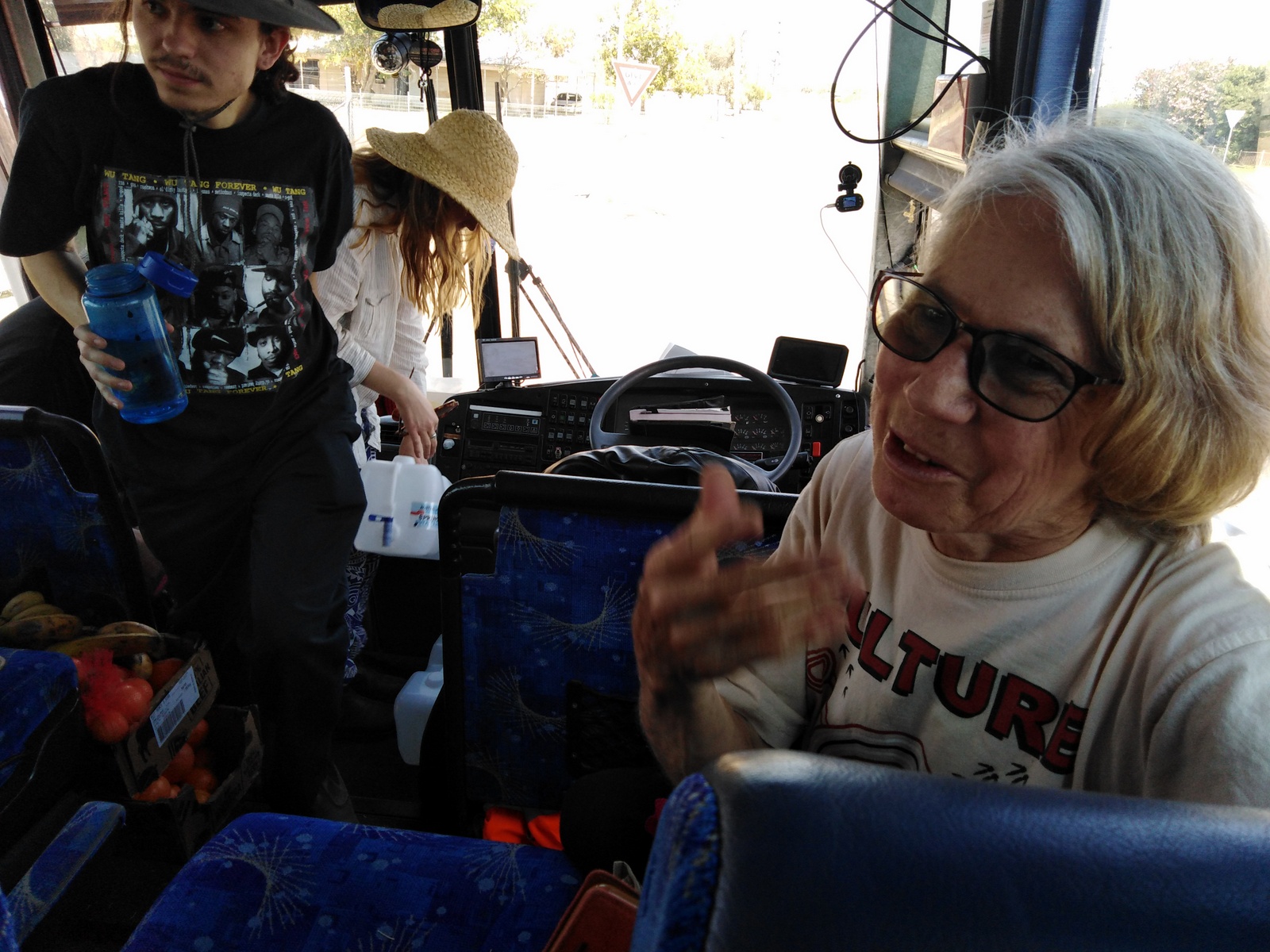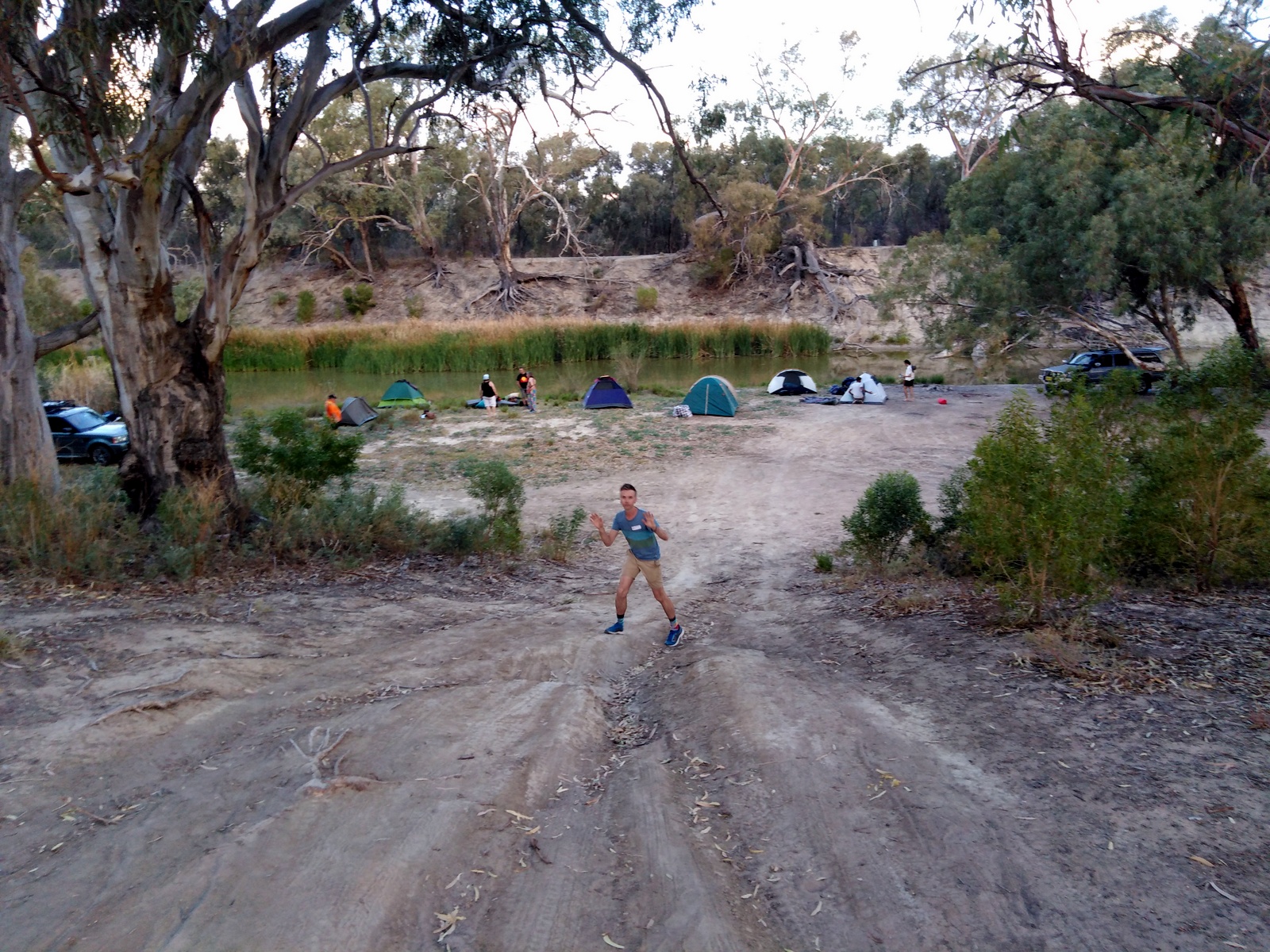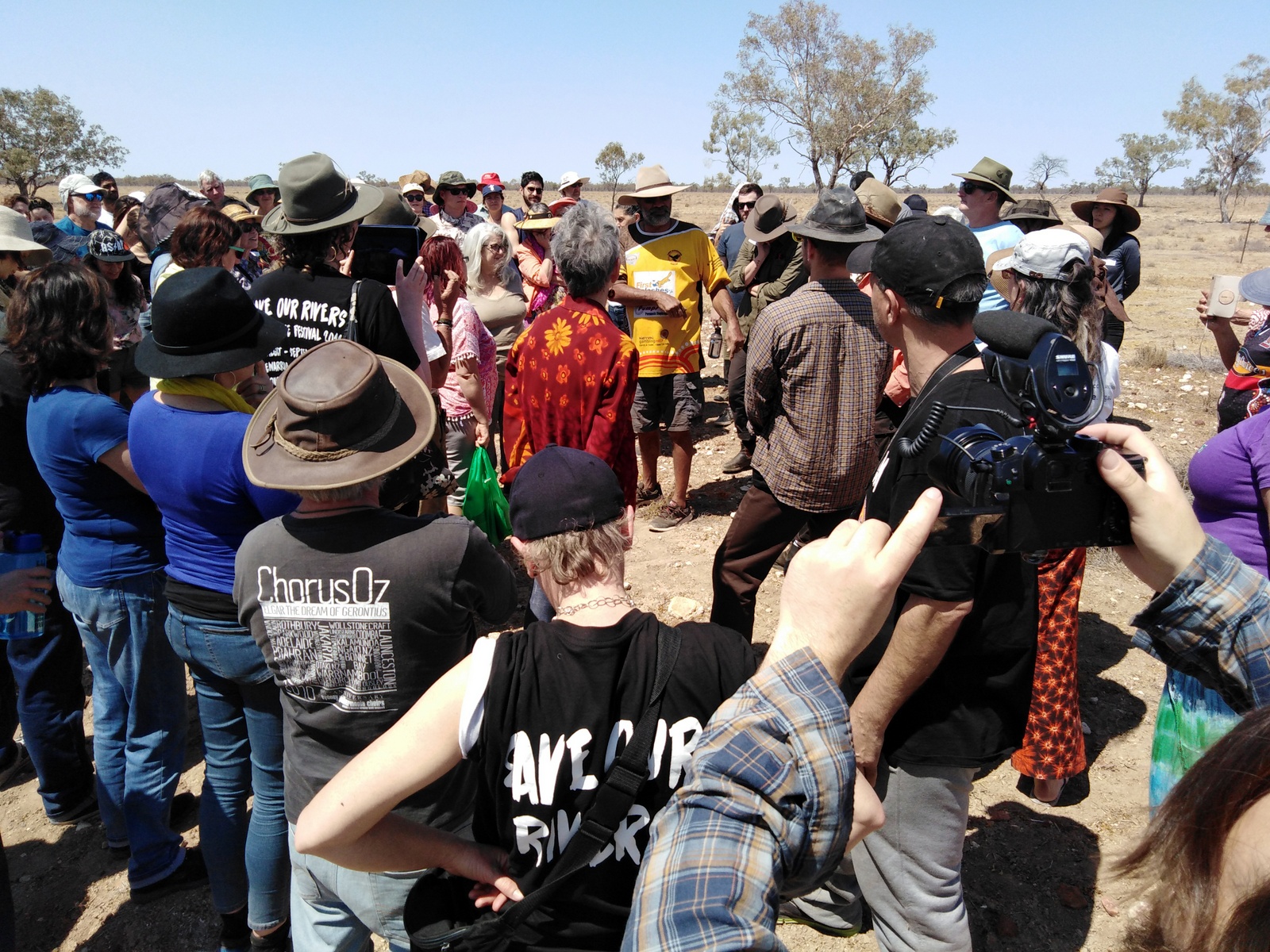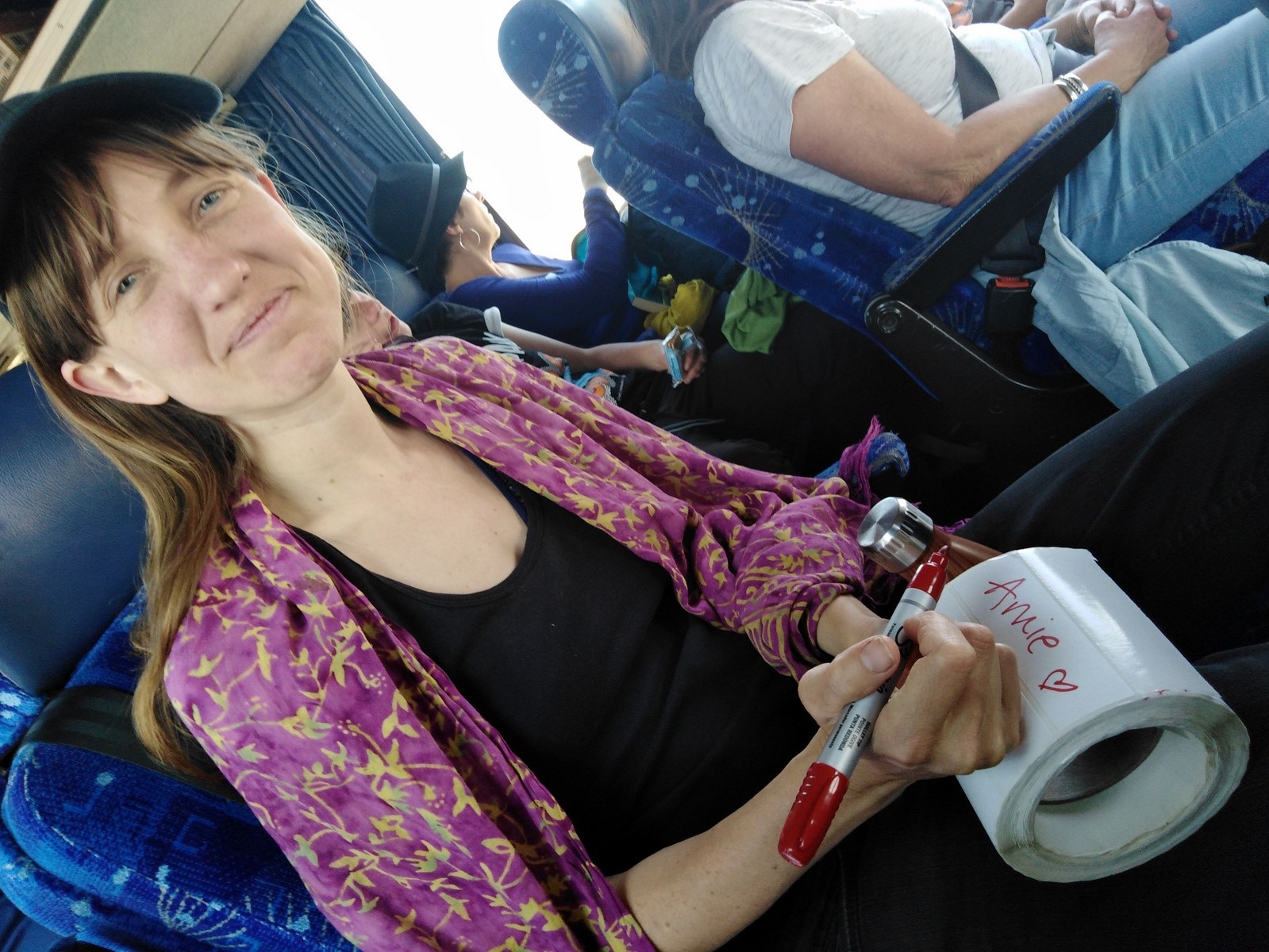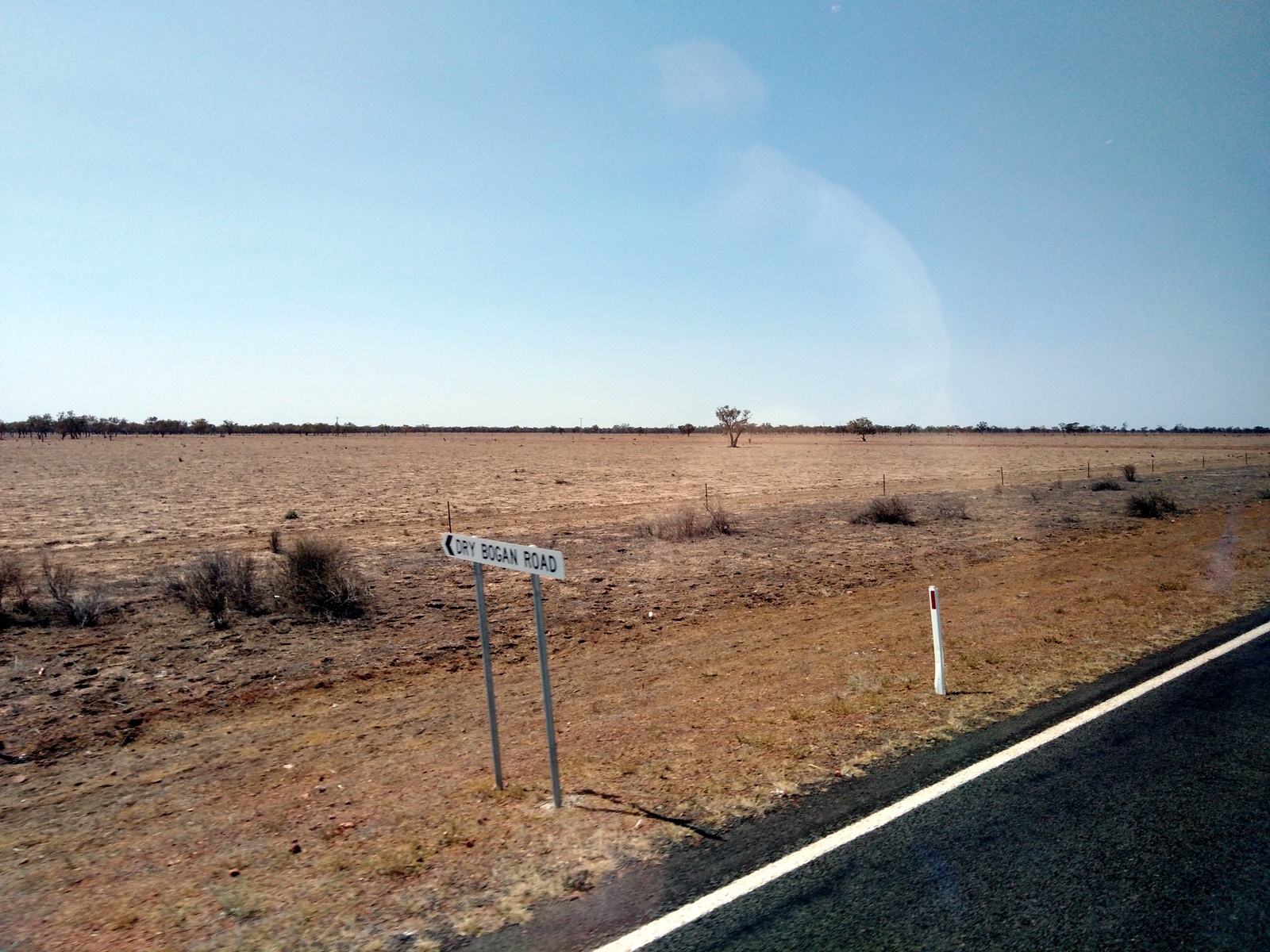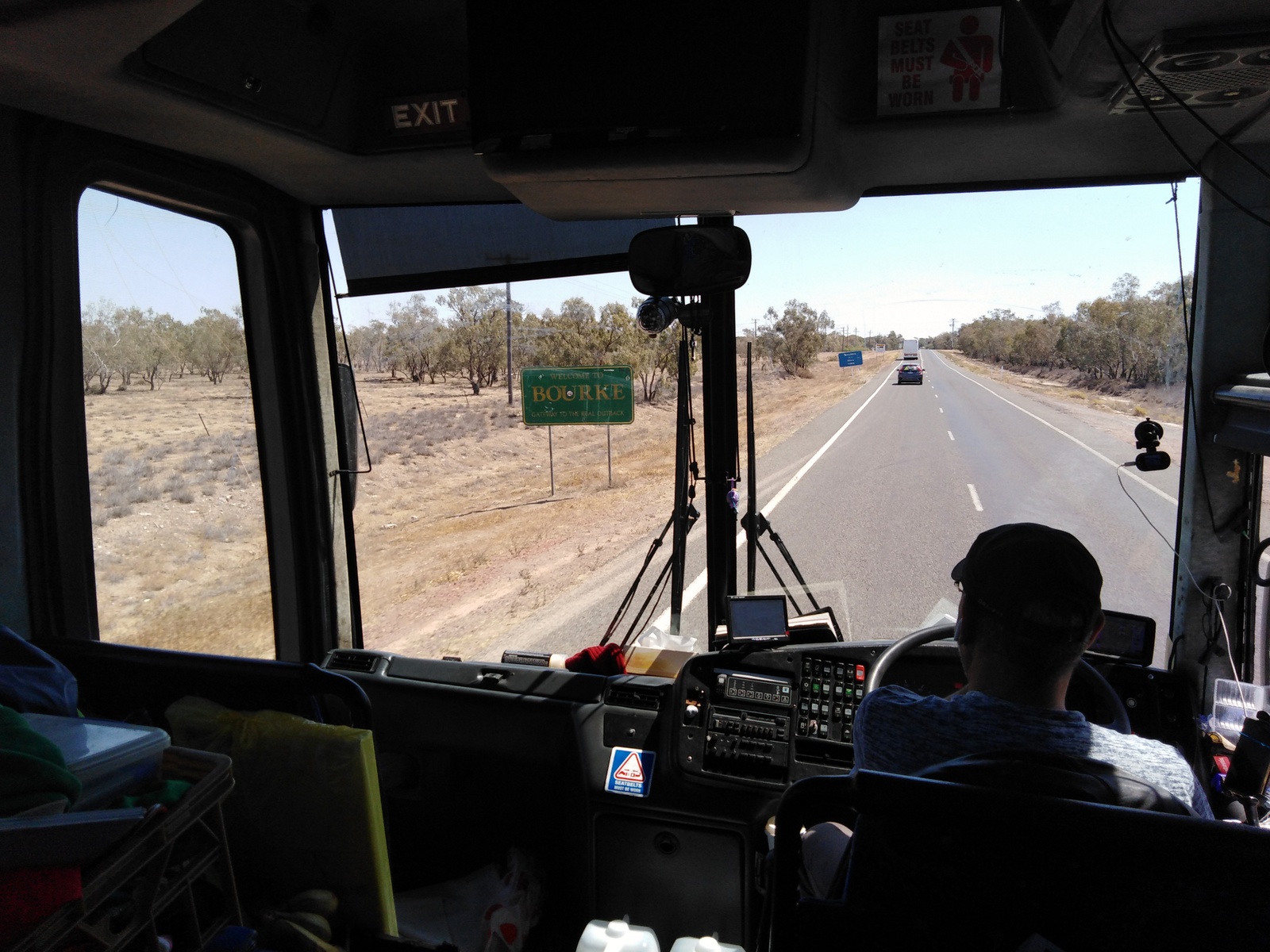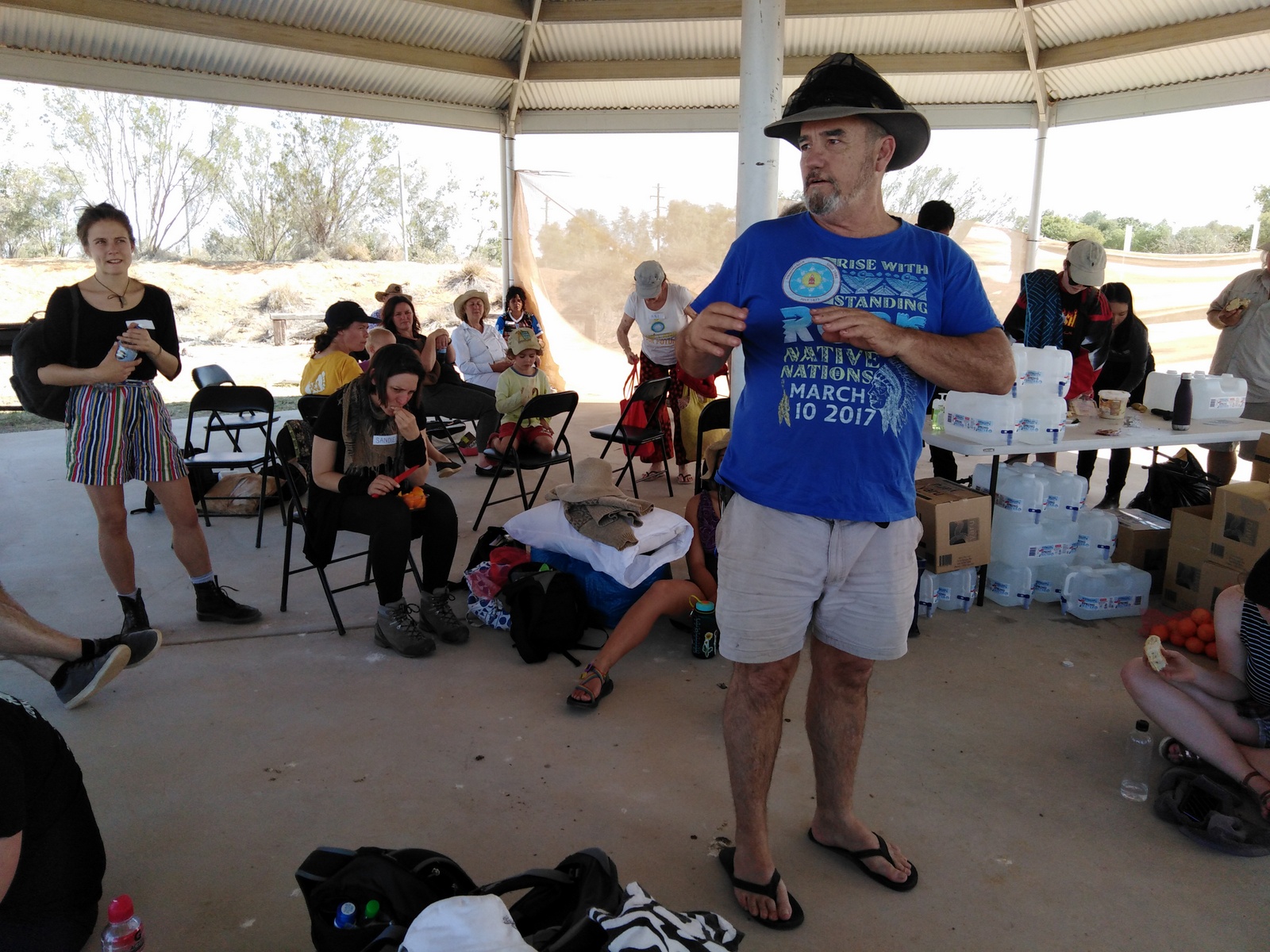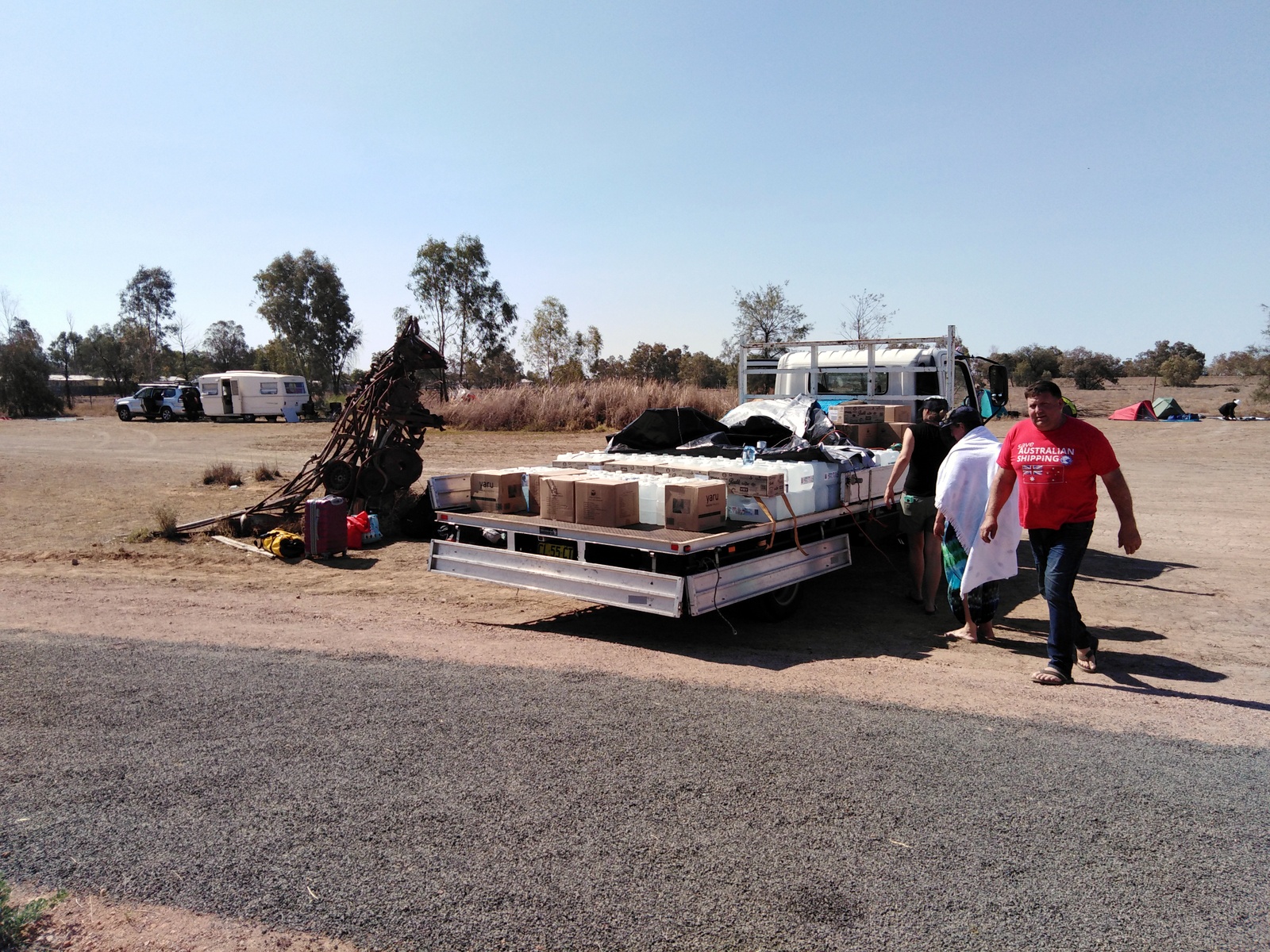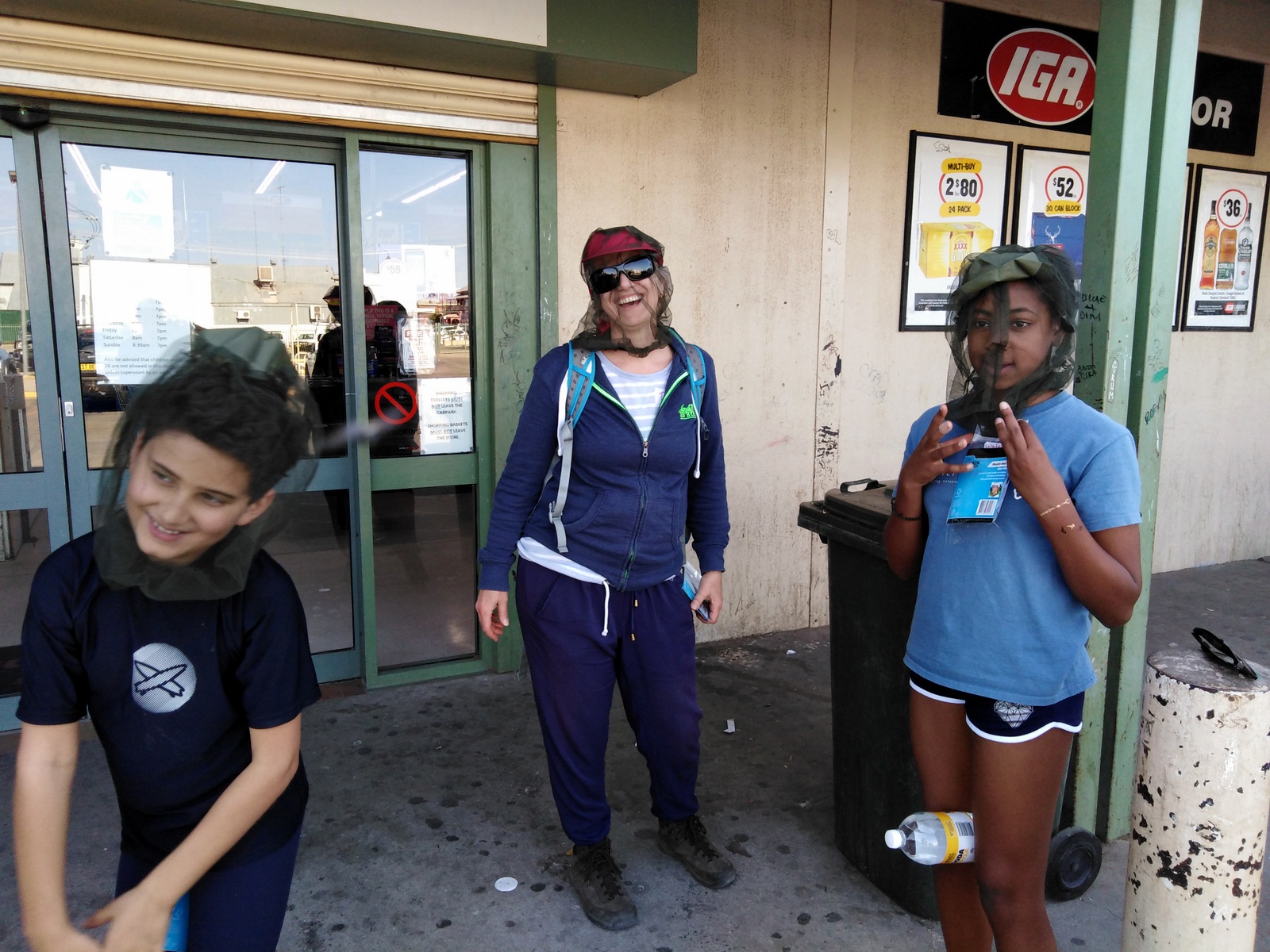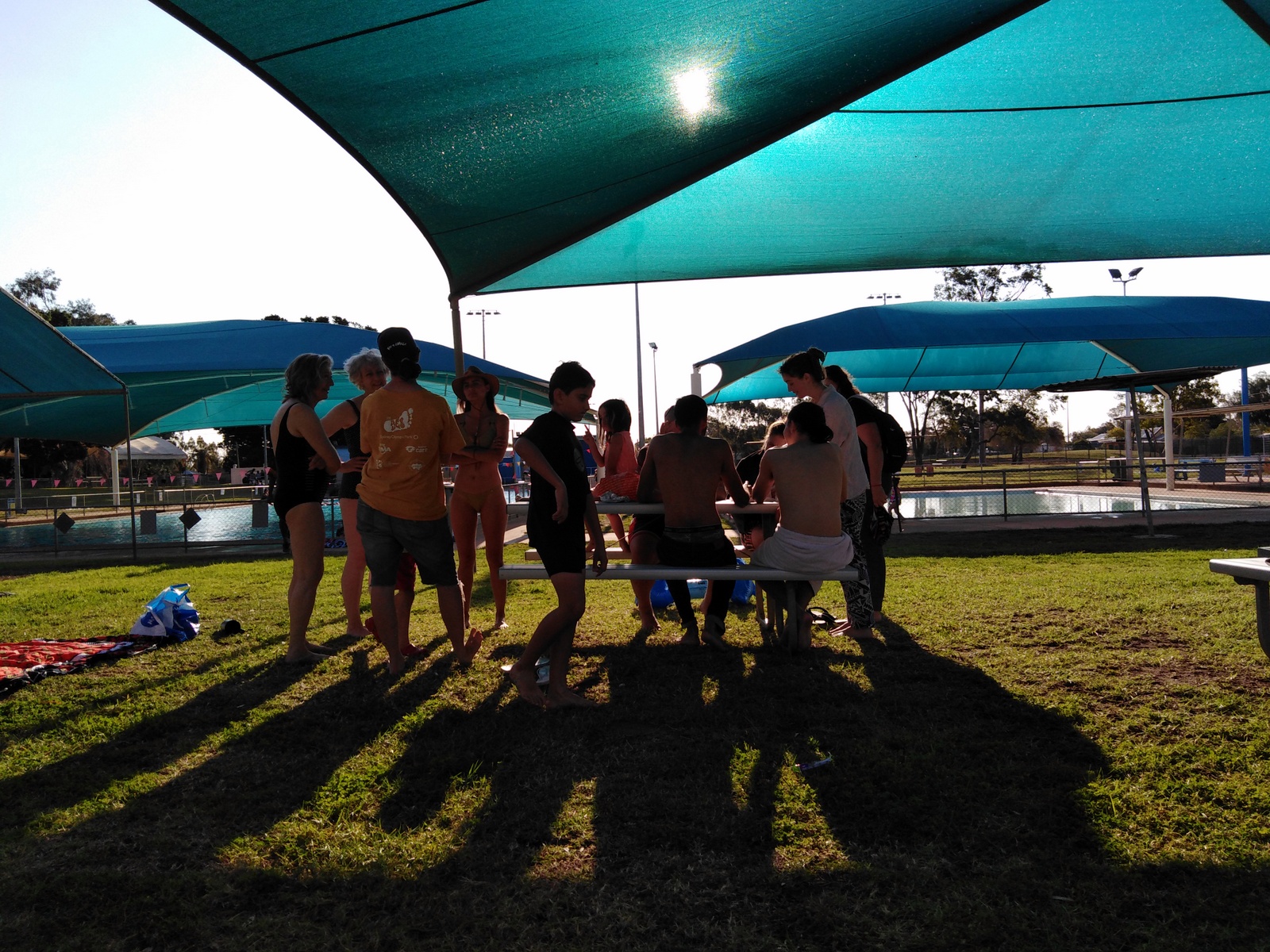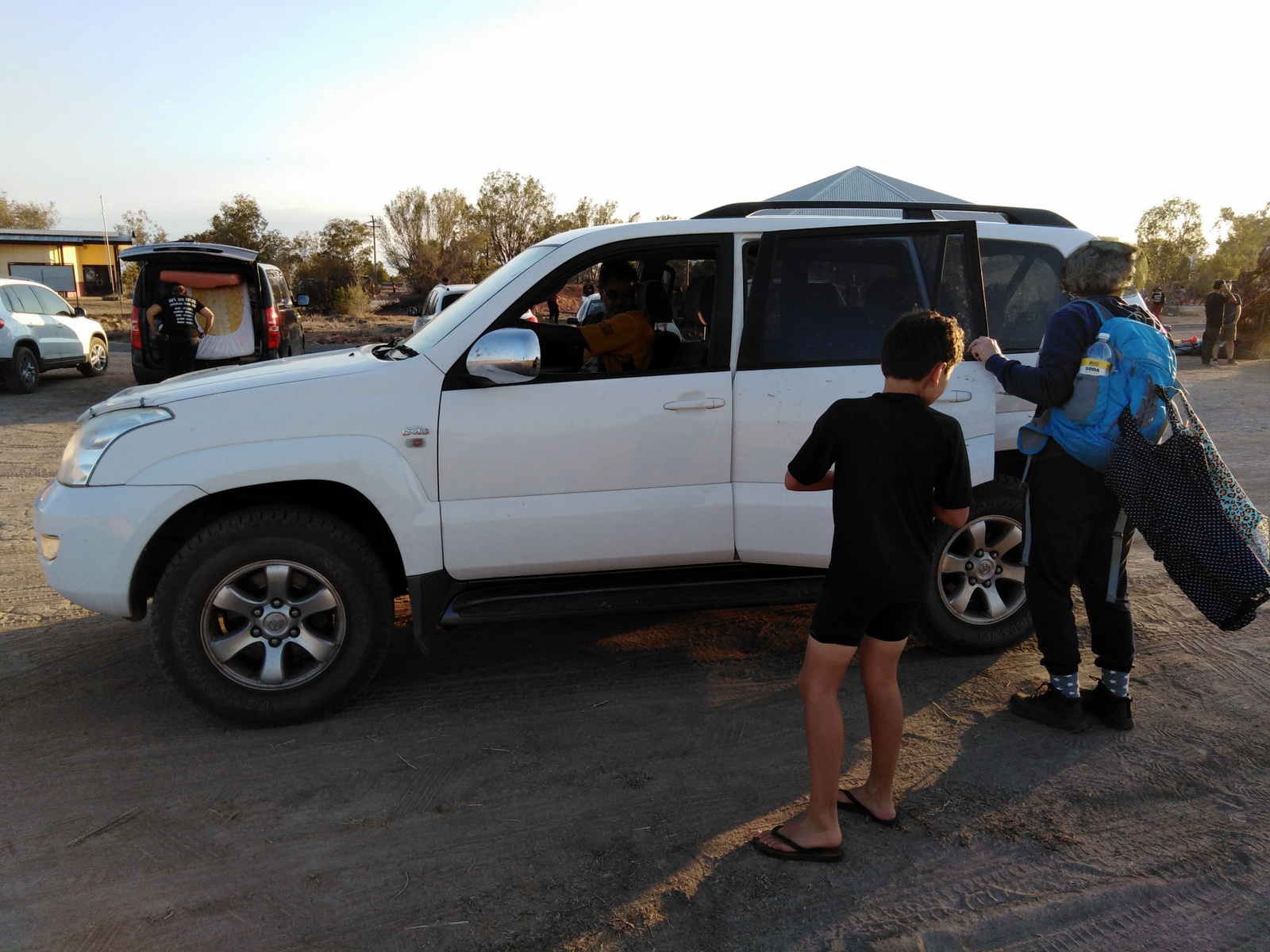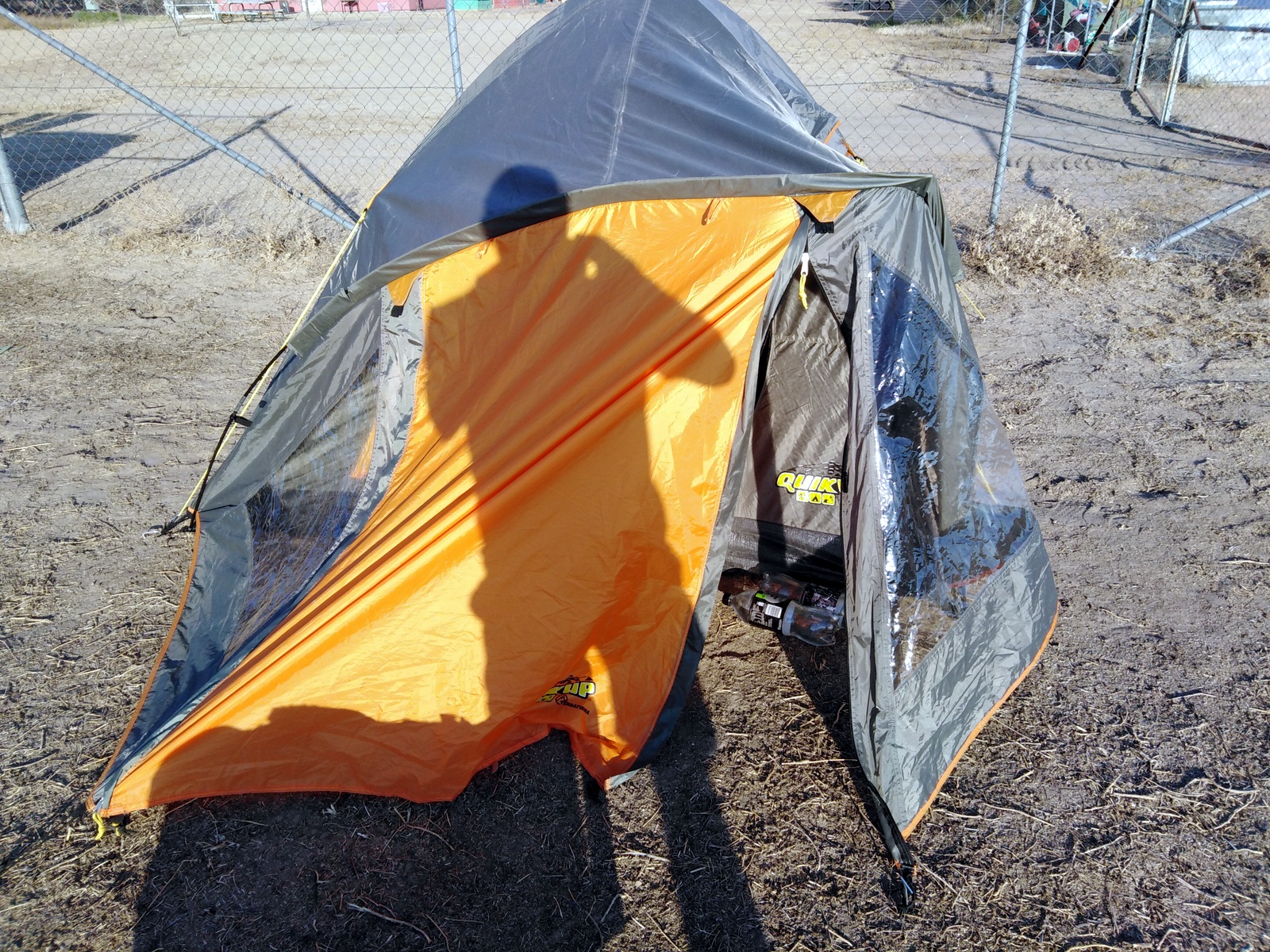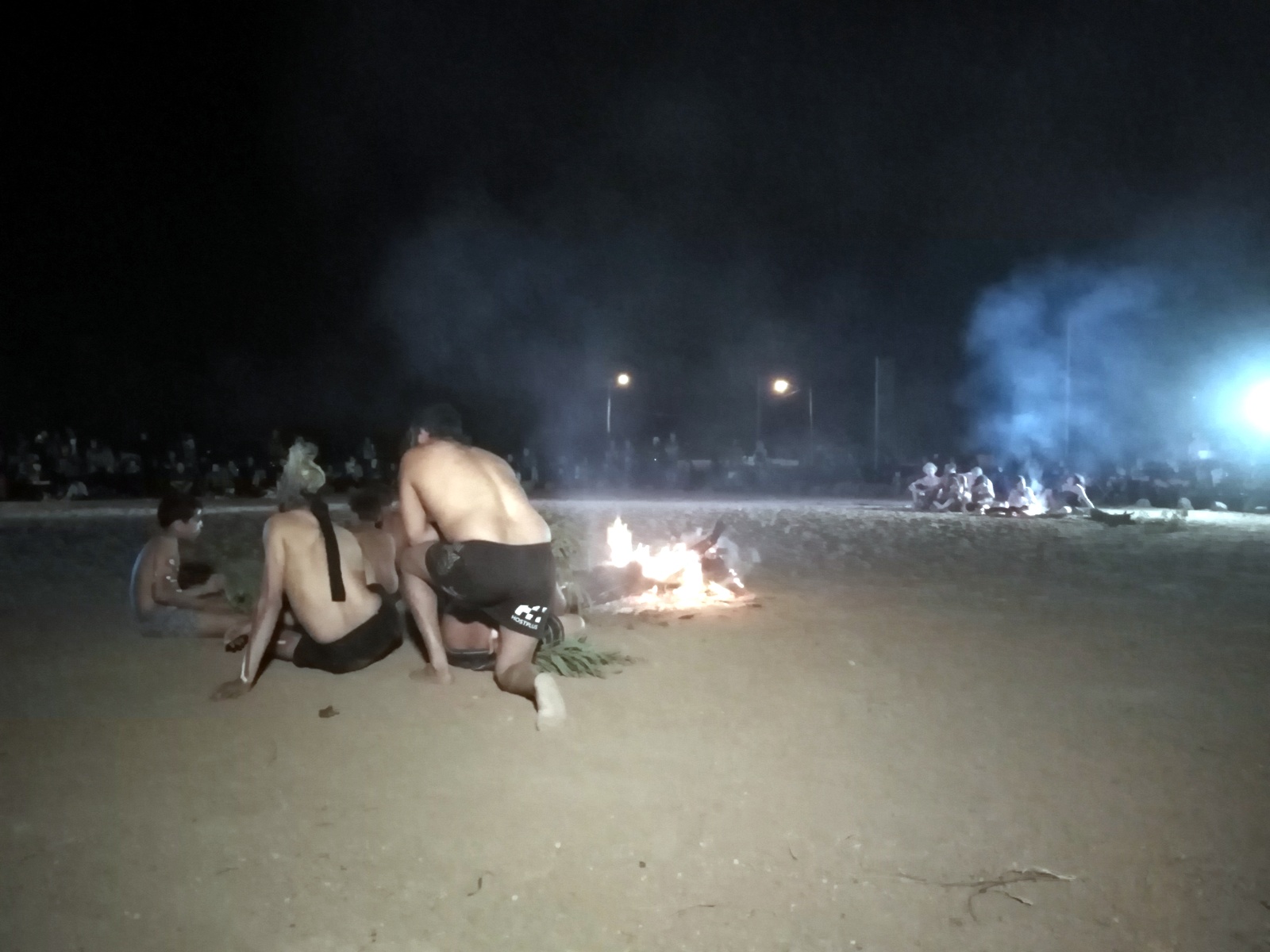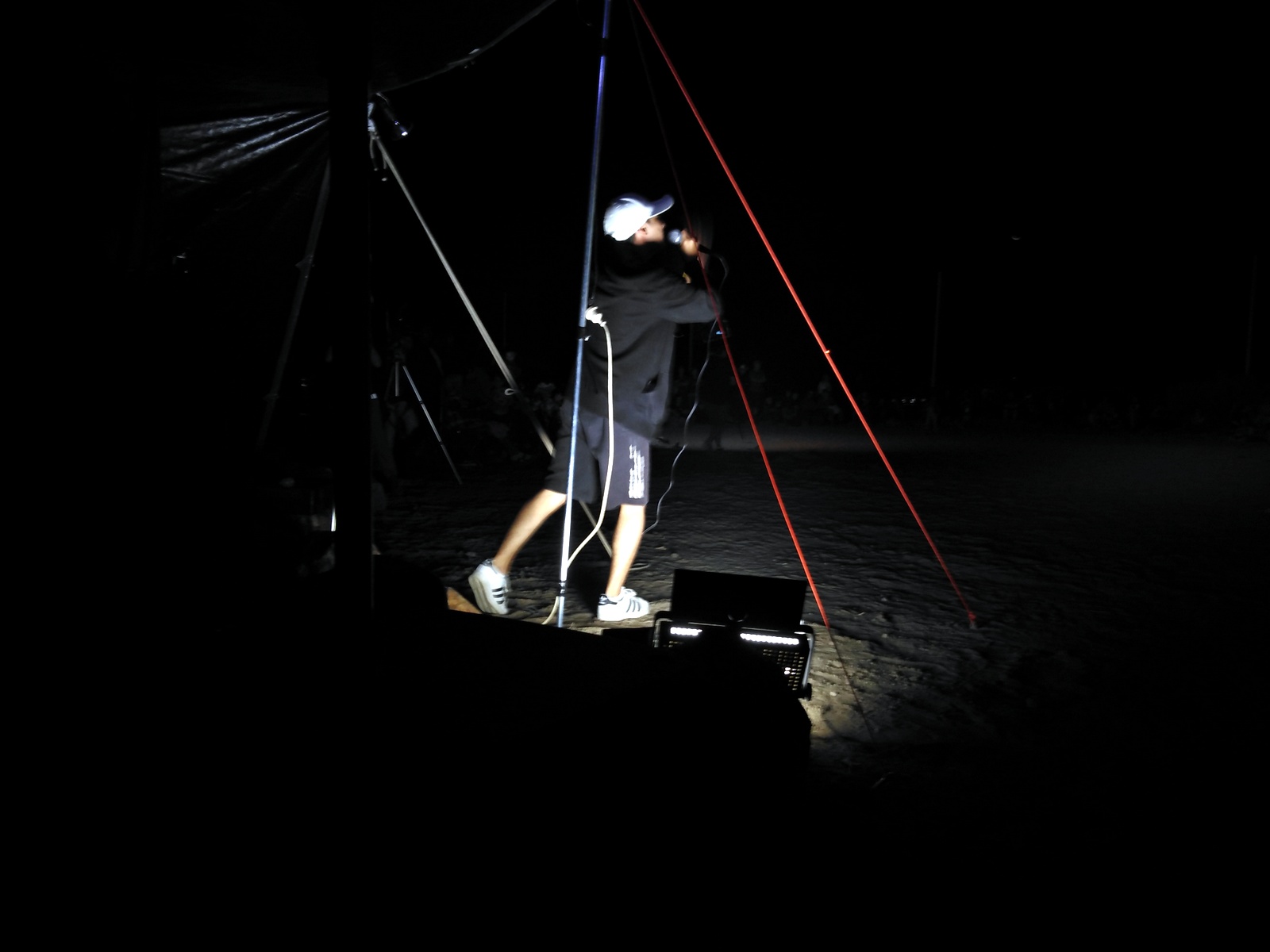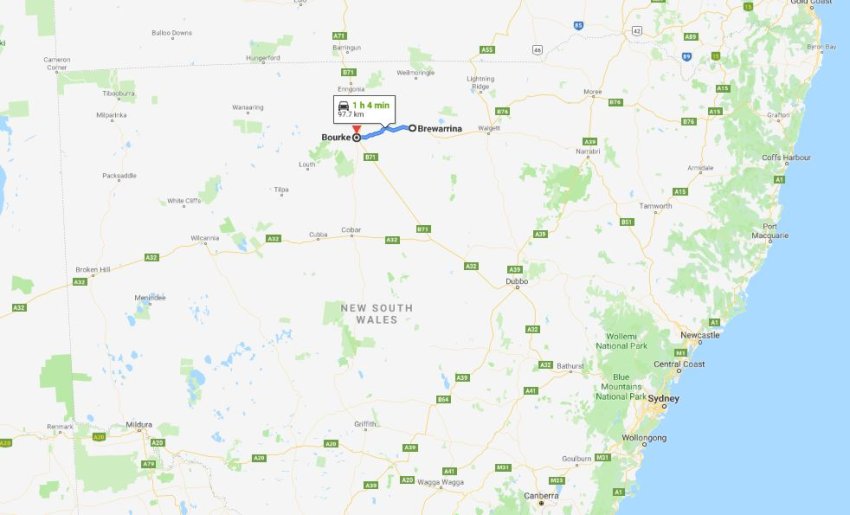
Well-documented corruption on a huge scale has dried out the Murray-Darling river system. Aboriginal communities along the river and its tributaries are calling it genocide. From September 28 to October 4, Aboriginal activist Bruce Shillingsworth helped those communities hold the Yaama Ngunna Baaka Corroboree Festival to educate the wider public about the crisis. Two buses left from Sydney to follow the festival. Green Left Weekly's Mat Ward, who took his nine-year-old son on the second bus, gives a blow-by-blow account of the trip.
Day 2: Brewarrina to Bourke
7.00am The campsite shower looks like it might electrocute me
After waking up with about 20 prickly bindies in my buttocks, I eventually manage to get myself to the toilets, where the shower looks kinda scary.
I consider washing my balls in the sink instead, with my anus showing, but decide against it as there is a queue for the sink.
I brave the shower. It's freezing, but safe.
7.30am Breakfast is good - with good company
Breakfast is a huge spread. Over the boxes of cereal I meet a woman from the first bus, Debbie. She tells me the town of Walgett, which the first bus got to visit, was different to Brewarrina.
"The river was very dry and the huge fresh water mussels are dying out," she says. "They're as big as abalone.
"We also visited the RSL which was... fun.
"The Corroboree was more intimate among the trees by the river."
8.55am We need to talk to locals
Bruce Shillingsworth arrives and tells us we should all get out in the community at our next stop, Bourke, and talk to people if we can.
He's warm and open. It is obvious why so many people take a shine to him.
9.00am A quick group photo
We gather in front of the bus before we leave for the Brewarrina Aboriginal Cultural Museum, which highlights Brewarrina's ancient fish traps, the oldest human-made structure in the world.
Bruce Shillingsworth gives a quick recap of the day's plans.
9.17am It takes a while to find the museum
On the way, we pass golfers and kangaroos on Brewarrina's red dirt golf course. The golfers wave at us. Strangely, the kangaroos don't.
9.30am There's someone from Kurdistan on the tour
I chat to Zana, a Sydney-based philosophy graduate from Kurdistan, as we queue for the museum.
"There are similarities between Kurdistan and desert Australia," he says. It faces similar issues, such as ancient places being destroyed.
"Even though Kurdistan is mountainous, it has plateaus that look like this. I like to come out somewhere like this and think, 'Could someone like me really live here?'"
9.50am The fish traps are a monument to cooperation
Our tour begins. Museum guide Shinee Hammond says: "Eight different tribes built the fish traps - a sign of peace and collaboration.
"Of all the experts who've come and studied them, no one really knows how old they are. Some say 120,000 years old.
"The natural weir was blown up to make the modern weir by people who, like the Americans, had dreams of growing cotton. We've all seen where that's got us now. No water."
9.53am The tour is very hands-on
Hammond passes round artefacts. A petrified witchetty grub (pictured), a cutting tool and ground mica, "used as decoration - like makeup".
We watch a short film on the creation story of the river, how it was formed by a "big black fish", Ponde, the Murray cod.
"That big black fish," says someone in the film. "What happened to him? Well, he got away..."
10.00am The world's oldest bakery is also near here
We move on to a collection of tools and artefacts, including the bones of diprotodon, the giant wombat.
"This is a grinding stone from Cuddie Springs, 70 kilometres from here, the world's oldest bakery," says Hammond.
"This museum shut down in 2012 and people tried to break in, so some of the artefacts were taken to a museum in Sydney."
She passes round mulga wood clubs and weapons, an emu caller and an axe made from the Achilles' tendon of a kangaroo.
10.10am The river's freshwater mussels are really big
Hammond passes round a shell of one of the river's freshwater mussels, which are now dying out at Walgett because of irrigators' corruption.
"At The Big Fish in Brewarrina, my dad caught one on his line - he thought he had a big fish," says Hammond.
Someone from the group asks: "Can you drink the water from the river?"
Hammond replies: "Yes, that's the water that comes out of our taps so we have to drink it."
Then she adds, sadly: "Some of our own local people agreed to the weir because they were getting big money from the federal government."
10.27am There was a massacre of Aboriginal people here 160 years ago
"Four hundred and twenty people were killed over a farmer that went missing, but he was found two weeks later," says Hammond.
"There are inaccurate stories on Google, so we like to set the record straight.
"Babies were killed with rocks and swung against trees."
10.29am The missions destroyed Aboriginal culture
"In 1886, the missions were opened," says Hammond.
The federation of Australia in 1901 was promoted with the line "Australia is expanding".
"But there were 26 different languages spoken on the mission," says Hammond. "So while Australia was expanding in 1901, for us it was getting smaller.
"We worked 12 to 13 hours a day to get a food ration at the end of the week."
10.42am The fish traps are stunningly beautiful, backed by an ugly modern weir
We walk along the length of the fish traps. "Growing up we were told we don't own the river or fish traps - we belong to them," says Hammond.
"They blew up some of the fish traps on the other side of the weir. These days the fish traps are not well preserved."
10.44am 'So when did the colonial bastards arrive?'
As we walk along the river's edge, organiser Rachel Evans (pictured in a black cap) asks Hammond: "So when did the colonial bastards arrive?"
The first invaders, euphemistically known as "settlers", arrived in the district about 1839. The first people to own land where the town now stands were the Lawson brothers, who had two holdings - one called "Walcha" and another called "Moona".
The town was first known as "Walcha Hut" but this later changed to "Brewarrina".
The name Brewarrina is derived from "burru waranha", a Weilwan name for a species of Acacia, Cassia tree, "Acacia clumps", "a native standing" or "place where wild gooseberry grows".
10.45am Brewarrina also has one of Australia's largest ochre pits
Just metres down river from the fish traps is one of Australia's largest pits of ochre.
"It was used for burial and skin medicine," says Hammond. "The ochre was taken 70 kilometres away to Gundabooka."
11.00am Visiting the museum is a good opportunity to give money back to the community
The previous night, an organiser from the first bus, unionist Joe McDonald, showed us a $150 painted emu egg he'd bought from the museum that day. He told others to buy something similar to put money back into the community.
We bought a $50 decorated coolemon - a bowl-like implement using for hunting and gathering.
11.02am This is how it helps
As we're walking away, Hammond comes after us and pulls us up to explain how buying such things helps the community.
"This coolemon was made by someone in the Orana Haven drug rehab down the road, so buying it helps the patients," she says.
11.05am Bruce Shillingsworth travelled all over getting people to come on this trip
As we're waiting for the bus to leave, we get chatting to fellow passenger Annie Nielsen, a former science teacher.
She's from Parramatta but lives in Winston Hills in north-west Sydney.
"I was very concerned about the Murray-Darling and heard about the trip in our Western Sydney reconciliation group," she says. "Bruce Shillingsworth came along and talked to us.
"My husband is Phil Bradley, the first Greens councillor on Parramatta City Council. Unfortunately, he couldn't come along."
11.36am There are quite a few people from Green Left Weekly on this trip
As the bus leaves for Bourke, we grab Matt Egan (pictured at one of the campsites), from Hurlstone Park in Sydney, for a chat.
He works as a webmaster for Green Left Weekly and also helps out with administration for the publication. He was also brought in to help with the tour later on.
"It was a spur of the moment thing for me to join the trip," he says. "Rachel Evans encouraged me. Bruce Shillingsworth also inspired me when he said the tour was inspired by the Freedom Ride by Charlie Perkins."
11.54am Our comedic bus driver, George, has some comedy competition
We pull over by the side of the road to stop for a Dreamtime story by Peter Williams, the senior dancer at Waradah Aboriginal Centre. He raised lots of laughs with his jokes, and his anarchic kids, at the Corroboree the previous night.
His clan is the Gurul Giyalu Rock People, and their language, Wongaipuwan. He points at Mount Yampaacoona on the other side of the road.
"The men used to collect rocks for grinding stones there," he says. "They'd use a bull roarer to warn that they were conducting men's business."
A woman on the tour asks him how the women would warn the men off when they were conducting women's business. "The women just had a big stick," he laughs.
12.01pm There are also some experienced campers on this trip
Disability support worker Amie, originally from Maitland in New South Wales, often goes camping around Canberra where she lives. She also once went on a long cycling and camping trip through far-north Queensland.
"I came on this trip because it was too good an offer to turn down really," she says. "I've always wanted to come out west, but I guess the deeper reason is to face the effects of climate change and colonial land degradation from an Indigenous-led community, grassroots context."
12.45pm There's plenty to see when you're driving through the outback
It may look like there's nothing of interest out here, but if you think that, you'd be wrong.
Keep your eyes peeled for plenty of blink-and-you'll-miss-it moments: a dead emu whose rigor mortis has left its legs sticking straight up in the air; a willy-willy whipping tumbleweeds up into the sky; or dubious road signs, like this one for Dry Bogan Road, seemingly pointing nowhere.
12.50pm We can't find the Bourke campsite
We're circling Bourke's suburbs as the address for the campsite isn't showing up on GPS.
2.30pm 'Be careful in Bourke'
Joe McDonald, the organiser from the first bus who bought the painted emu egg, says the locals have told him to tell the group to take care in Bourke at night.
"This is a different town to Brewarrina or Walgett and you have to be careful," he says.
"Also, regarding the toilet situation, there are only three portable ones because they wanted you to experience what it's like to live with water shortages, so don't complain because NOBODY GIVES A FUCK. Oh... sorry about that swearing, for the children."
2.45pm This water truck cost us about $3000
NSW Rural Fire Service had agreed to provide water at each campsite we are going to stay at. However, organiser Rachel Evans said that two days before the tour started, they pulled out to fight bush fires in Queensland, so the organisers had to pay about $3000 for this water truck to follow us around, lest we die.
3.00pm The thirsty flies in Bourke may drive you insane
We walk into town looking for fly nets as the flies are driving half the camp mad as they try to get into our eyes, mouths and ears.
Half the camp have beaten us to it, it seems, as every outlet we're directed to has sold out.
Eventually we find the last three in the town at an IGA supermarket - and buy them all.
3.50pm Bourke has a very nice - and cheap - pool
It seems half the camp has also decided to avoid the heat by coming to the public swimming pool, whose flat entry fee is a bargain $2.
5.00pm We manage to get lost in Bourke
We wander the streets looking for the town's showground, which is where we have been told the evening meal is being served.
Senior dancer Peter Williams tracks us down in his big white 4WD and tells us the meal is actually at the campsite. "Hop in," he says.
I ask him if he helped organise the Corroboree festival. "No, no, it was all Brucey," he says.
Is Bruce Shillingsworth an old friend? "Yeah we go back years," he says. "We went to school together for one year."
5.15pm The heat in Bourke may break your tent
The reason why my wife, who is also my son's mum, isn't travelling with us is because we once made her spend a week with us in a sweltering, collapsed tent after the 40oC heat made its poles shatter. My wife vowed to never camp again.
My son and I, meanwhile, got the shattered poles replaced and vowed never to camp in the sun again.
However, when we arrived in Bourke, my son insisted we camp in the sun, next to the rest of our group. In the heat of the moment, I agreed. This is the result - a broken front pole.
6.00pm Dinner has been prepared by the more honourable members of the tour
While we were at the pool, the more honourable members of the group were preparing food for the evening. I take a picture of the meal, but my mobile phone is struggling in the dark, as it does throughout the tour.
We are told it is mostly the women who are volunteering to prepare the food and the kitchen needs.
While I eat, rapper Dobby walks up, who is more hopeful about the sound system working for tonight's performance. I tell him everybody was raving about his performance on the megaphone the night before.
7.00pm The Corroboree circle is a lot bigger than last night
The Corroboree has been advertised in the local gig guide and plenty of cars have turned up.
Bruce Shillingsworth opens the festival by saying: "Thank you for coming. I never thought I'd see so many people coming down here tonight. I want to really thank you because without the river, where would we be?"
The anger at the corruption is so serious, it appears that Bourke Shire Council felt they should show up and take to the microphone. Mayor Barry Hollman and general manager Ross Earl are here, as well as the regional engagement officer for the Barwon Darling Region with the Murray Darling Basin Authority, Peter Thomas.
7.30pm Dobby takes the mike
"It's so great to be travelling with you all," he says. "I've been in Walgett, last night Brewarrina where my family's from."
Again, he is struggling with a distorted sound system and almost resorts to using a megaphone, but still manages to win the crowd over.
His song about the corrupt irrigators, "Language Is In The Land", gets the biggest cheer of the night.
He does an encore by getting some crowd participation going that has everyone in stitches.
8.00pm The Corroboree ends slightly early and a film is shown
Bruce Shillingsworth says they have to end the Corroboree as someone is sick. He closes with some rousing words: "The people are going to manage our rivers just like we used to for thousands of years. We are going to send a message to the Australian government. This is a form of genocide.
"We're going to bring back our culture. We're going to bring back our dance and music. We are the protectors of the rivers. We are the protectors of the Earth.
"Our voices are going to be heard not just here but right across the world."
Over at the campsite, a projector is set up to screen My Life as I Live It, a film about Essie Coffey, a Murruwarri woman and co-founder of the Western Aboriginal Legal Service. She was awarded a Medal of the Order of Australia in 1985 for service to the Aboriginal community and was nominated for an Order of the British Empire (MBE) but refused it, explaining: "I knocked the MBE back because I'm not a member of the British Empire."
On the way back to our tent, my son carves "water for the rivers" and "save our rivers" into the dirt.
Read about Day 3 here.
Comments? Criticisms? Corrections? Email criticalfilms@gmail.com
[Mat Ward has been writing for Green Left Weekly since 2009. He also wrote the book Real Talk: Aboriginal Rappers Talk About Their Music And Country and makes political music.]


